Belarus is located in Eastern Europe, bordered by Russia, Ukraine, Poland, Lithuania and Latvia. It has a diverse range of habitats, including forests, wetlands, rivers, and grasslands, which provide ideal conditions for a variety of bird species.
Birdwatching is a popular activity in Belarus, with enthusiasts flocking to the country to observe the abundance of birdlife. This article presents a comprehensive list of birds found in Belarus, providing an insight into the diverse avian fauna of this unique country.
From majestic birds of prey to colorful songbirds, Belarus is an ornithologist’s paradise, with something to interest bird lovers of all levels of experience.
1. Plovers

Plovers are a family of around 64-68 species of ground-dwelling birds, commonly found in open country such as fields, meadows and tundras.
They have short bills with webbed feet to help them forage through mud or shallow water.
Plover plumage is usually mottled brown though some species may have brighter colors on the head and wings.
These birds feed mainly on insects but can also eat small crustaceans and worms.
Plovers breed during springtime when they dig holes in sandy or pebbled beaches to lay their eggs which hatch after about 3 weeks incubation period.
They use distraction display behaviour by pretending an injury to the predators away from their nests if needed for protecting their young ones.Scientific classification:
| Kingdom | Animalia |
| Phylum | Chordata |
| Class | Aves |
| Order | Charadriiformes |
| Family | Charadriidae Leach, 1820 |
Also Featured In: Most Common Birds in China, Most Common Romanian Birds
2. Glareolidae
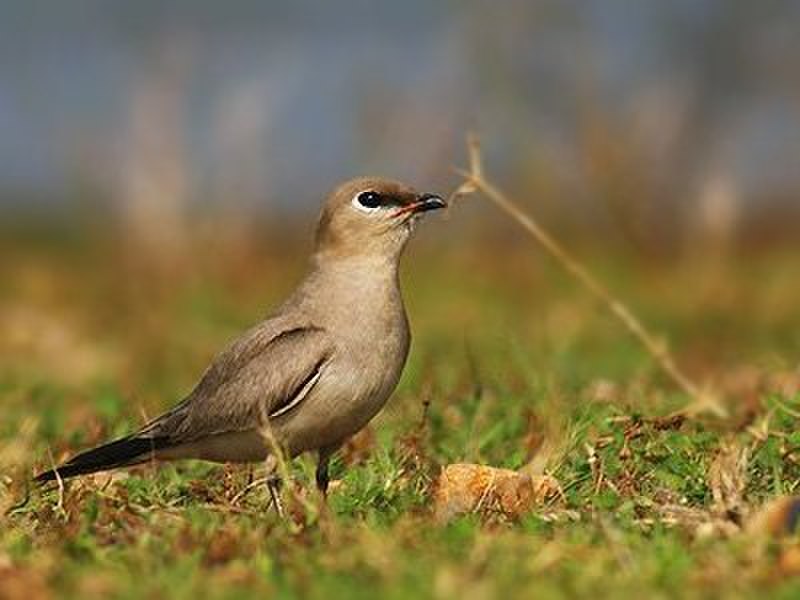
Glareolidae is a family of wading birds, consisting of four genera and 17 species. They are distinguished from other charadrii by their long bills which have a slight downward curve.
Glareolidae live around open grasslands and deserts, where they hunt for insects using the bill to probe into soil or vegetation.
Most species are found in Africa but two pratincoles inhabit parts of Europe and Asia as well.
Coursers tend to be larger than pratincoles with longer legs allowing them to run quickly across sandy dunes while feeding on small animals like lizards or spiders.
Pratincoles feed mainly on flying insects, snatching them out of midair with great agility during flight.
All glareolids share unique features such as large eyes that help it spot prey at night easily making this group one interesting bird family.Scientific classification:
| Kingdom | Animalia |
| Phylum | Chordata |
| Class | Aves |
| Order | Charadriiformes |
| Suborder | Lari |
| Family | Glareolidae CL Brehm, 1831 |
Also Featured In: Common Algerian Birds , Birds of Sweden
3. Gadwall
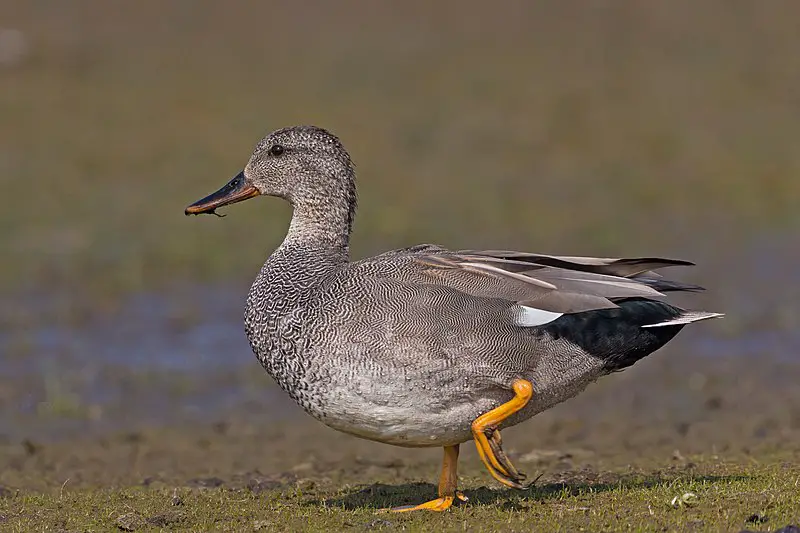
The Gadwall is a species of duck belonging to the Anatidae family. It was first described by Carl Linnaeus in 1758 and DNA studies show that it is closely related to the Falcated Duck, as well as three other Wigeons.
They are quite common and can be found across many parts of North America and Europe.
In terms of appearance, they have light grey bodies with white underbellies, brown wings tipped with black spots, yellowish-orange bills, dark eyes and distinctive chestnut heads which make them easy to identify among other ducks.
They prefer shallow wetlands but also inhabit ponds or lakes during winter migration season where they feed on aquatic plants such as pondweed or water lilies alongside small insects like beetles or dragonflies when available.Scientific classification:
| Kingdom | Animalia |
| Phylum | Chordata |
| Class | Aves |
| Order | Anseriformes |
| Family | Anatidae |
| Genus | Mareca |
| Species | M. strepera |
Also Featured In: Most Popular Bird Species in North America, Most Common Lake Birds
4. Stone-Curlew

Stone-curlews, also known as dikkops or thick-knees, are a family of birds that have adapted to live in tropical and temperate regions throughout the world.
They can be found in Africa, Asia and Australia with two or more species per region. Despite being classified as waders, most prefer dry arid habitats over moist wetlands.
Stone-curlews typically have long legs which help them navigate through their preferred terrain efficiently; some species even stand at an impressive height when standing on those long legs.
Additionally they feature cryptic plumage which helps them blend into their surroundings while hunting for prey such as insects and small mammals like rodents.
These unique bird’s calls are easily recognizable; it has been said that hearing one is similar to listening to someone whistling ‘Keee Weee’.Scientific classification:
| Kingdom | Animalia |
| Phylum | Chordata |
| Class | Aves |
| Order | Charadriiformes |
| Suborder | Chionidi |
| Family | Burhinidae Mathews, 1912 |
Also Featured In: Beautiful Brazilian Birds, Birds Found in Hungary
5. Aquatic Warbler
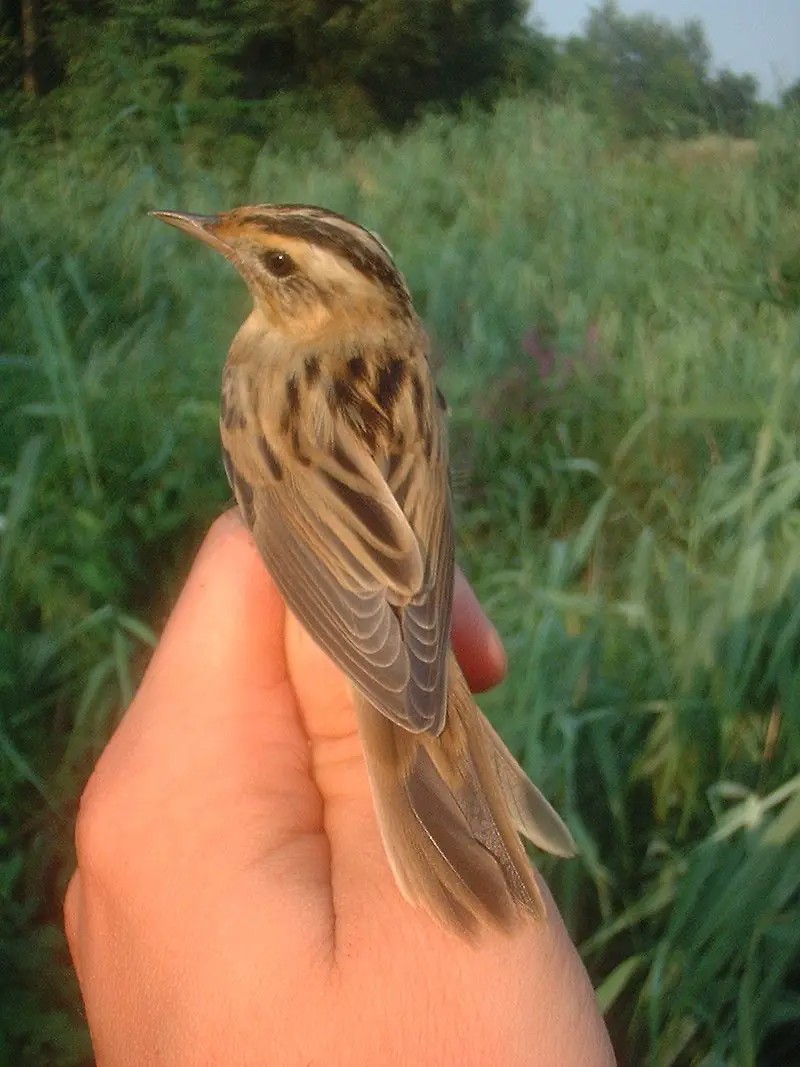
The Aquatic Warbler is a species of Old World warbler that can be found breeding in temperate eastern Europe and western Asia. It has an estimated population of 11,000-15,000 pairs.
This bird migrates during winter to west Africa where it spends its time until the spring months when it returns for the summer season.
Its exact whereabouts were unknown for many years but researchers eventually located them at Djoudj National Bird Sanctuary near Mauritania on the edge of the Sahara Desert.
They prefer wetland habitats such as marshes with dense reed beds which offer a suitable environment to nest and feed their young successfully each year.
With conservation efforts this species will hopefully continue to thrive in its natural habitat over coming years.Scientific classification:
| Kingdom | Animalia |
| Phylum | Chordata |
| Class | Aves |
| Order | Passeriformes |
| Family | Acrocephalidae |
| Genus | Acrocephalus |
| Species | A. paludicola |
Also Featured In: Russian Birds, Most Common Lithuanian Birds
6. Red-Footed Falcon
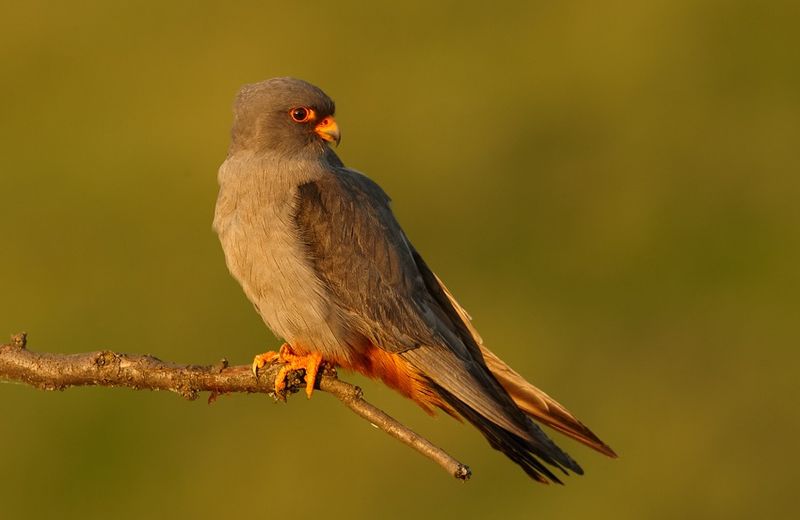
The Red-footed Falcon is a majestic bird of prey belonging to the Falconidae family. Found mainly in eastern Europe and Asia, numbers are unfortunately dwindling due to habitat loss and hunting.
This species migrates south for winter, with many birds making their way as far west as western Europe. In August 2004 one was even spotted in Britain; quite an impressive feat.
They have a striking plumage consisting of rich chestnut red legs contrasting against its grey wings and white underbelly – lending itself well to identification from afar.
The diet of this raptor mostly consists of small mammals such as mice or voles but it has also been known to feed on insects too.
A threatened species, conservation efforts must be made if we wish for generations after us to appreciate these beautiful falcons that soar across our skies.Scientific classification:
| Kingdom | Animalia |
| Phylum | Chordata |
| Class | Aves |
| Order | Falconiformes |
| Family | Falconidae |
| Genus | Falco |
| Species | F. vespertinus |
Also Featured In: European Birds,
7. Old World Flycatchers
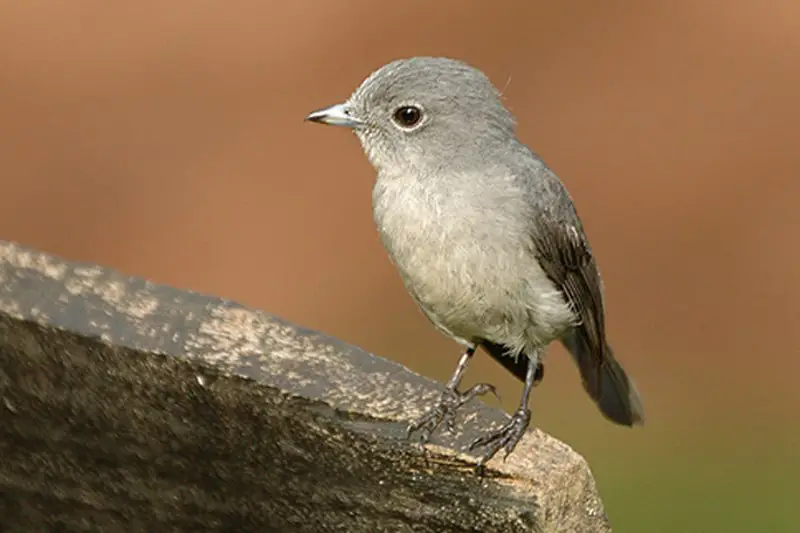
The Old World Flycatcher is a family of small passerine birds, native to Europe, Africa and Asia. They are mainly insectivorous arboreal birds that feed on insects they catch in the air or trees.
Their wingspan ranges from 5-11 inches long with males usually being slightly larger than females.
The coloration of these birds can range greatly depending on species but typically have dull greyish brown upperparts and pale undersides which help them blend into their environment for hunting purposes.
Bluethroat (Luscinia svecica) and Northern Wheatear (Oenanthe oenanthe) are two exceptions as they can be found in North America too.
These charming little creatures make fun additions to birdwatching lists all over the world because of their vibrant colors and interesting behaviors.Scientific classification:
| Kingdom | Animalia |
| Phylum | Chordata |
| Class | Aves |
| Order | Passeriformes |
| Superfamily | Muscicapoidea |
| Family | Muscicapidae Fleming J., 1822 |
Also Featured In: Common Birds in Japan, Birds Commonly Found in Slovenia
8. Shrike
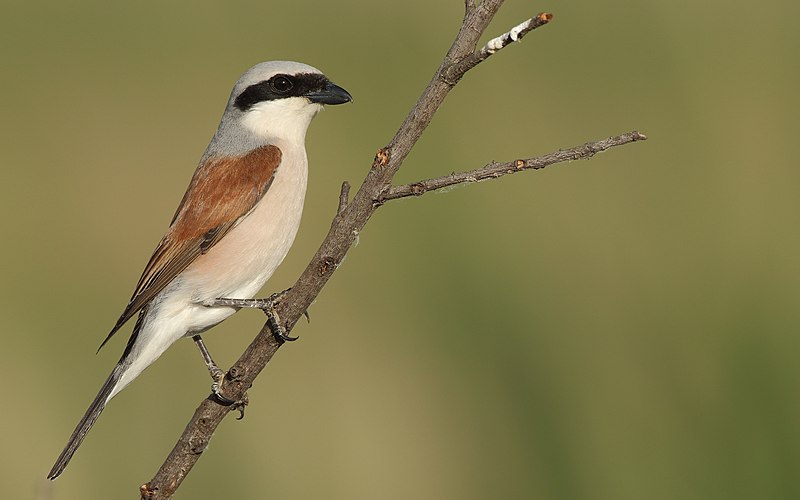
Shrikes are small passerine birds of the family Laniidae, with 34 species in four genera. They get their name from Old English word “scrīc”, which refers to their shriek-like call.
These birds have earned the nickname ‘butcherbirds’ due to their feeding habits; they impale prey on thorns or barbed wire fences for later consumption.
Shrikes also tend to be aggressive predators and hunt a wide range of animals such as insects, small reptiles, rodents and even other smaller bird species.
In terms of physical appearance, these songbirds can vary greatly depending on the specific genus but usually boast a large hooked bill atop an impressive crest along with bright colors like gray, black or brownish hues across its feathers.
It’s clear shrike is quite remarkable creature that has gained notoriety for both hunting prowess and distinctive vocalizations.Scientific classification:
| Kingdom | Animalia |
| Phylum | Chordata |
| Class | Aves |
| Order | Passeriformes |
| Superfamily | Corvoidea |
| Family | Laniidae Rafinesque, 1815 |
Also Featured In: Egyptian Birds, Common Serbian Birds
9. Old World Orioles
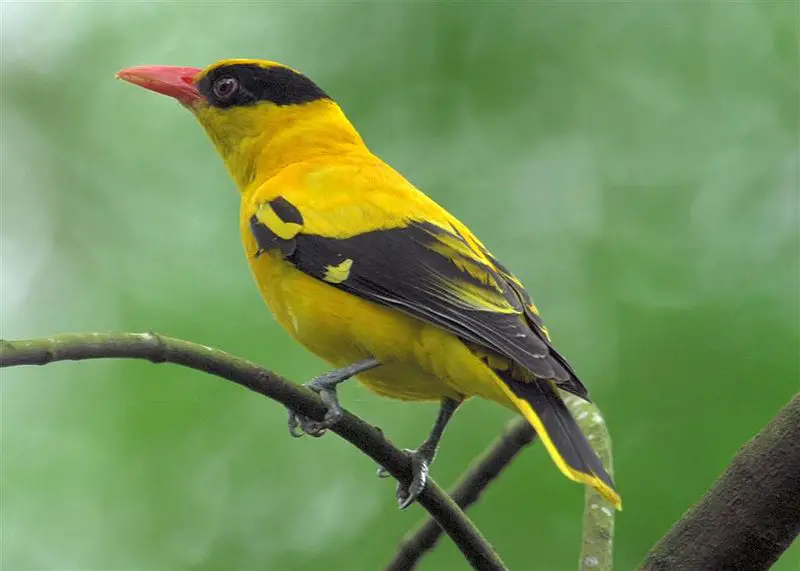
Old World orioles are a family of passerine birds found in the Old World. It comprises four genera: piopios, figbirds, pitohuis and the original genus Oriolus.
The African black-headed species have sometimes been removed from this latter group due to their distinct characteristics as well as other proposed splits for Oriolus.
These colorful birds can be identified by their bright yellow or orange plumage that often features darker markings on wings and head areas, although some species may also display a blue hue or stripes across the body feathers.
They typically feed on insects such as caterpillars and grasshoppers but will supplement with small fruits when available too – making them beneficial additions to gardens.Scientific classification:
| Kingdom | Animalia |
| Phylum | Chordata |
| Class | Aves |
| Order | Passeriformes |
| Superfamily | Orioloidea |
| Family | Oriolidae Vigors, 1825 |
Also Featured In: Bulgarian Birds, Common Denmark Birds
10. Eurasian Stone-Curlew
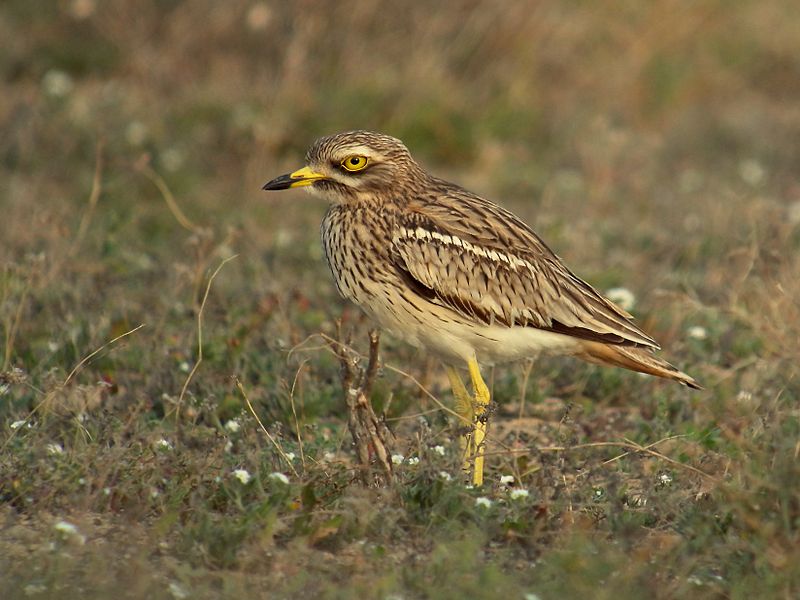
The Eurasian stone-curlew, also known as the Eurasian thick-knee, is a species of bird from the Burhinidae family. It was first described by Swedish naturalist Carl Linnaeus in 1758 and is mainly found in England.
These birds have brown feathers with black markings on their wings and head; they also possess long beaks for catching prey.
They usually feed on insects, small rodents, worms and other invertebrates that can be found near water sources or open areas such as fields and meadows.
Stone curlews are mostly active during night time but can occasionally be seen during day light hours too.
During breeding season these birds make loud calls to attract mates and ward off predators while defending their nests which are often built in grassy plains or dry moorside land away from human activity or disturbance.Scientific classification:
| Kingdom | Animalia |
| Phylum | Chordata |
| Class | Aves |
| Order | Charadriiformes |
| Family | Burhinidae |
| Genus | Burhinus |
| Species | B. oedicnemus |
Also Featured In: Birds You’ll Find in Night, Birds of Lanzarote
11. European Roller

The European roller is a beautiful bird belonging to the Coracias family, and it’s the only one of its kind found in Europe.
It inhabits various habitats such as dry wooded savanna, bushy plains and other areas except for treeless ones.
During wintertime they usually nest in tree holes, while their range extends into Middle East, Central Asia and Maghreb regions.
They have vibrant blue feathers with black stripes along the neck area which makes them stand out from other birds easily.
Its diet consists mainly of insects like grasshoppers or beetles that are hunted by catching them mid-air during flight; this feature adds an extra charm to these magnificent creatures.Scientific classification:
| Kingdom | Animalia |
| Phylum | Chordata |
| Class | Aves |
| Order | Coraciiformes |
| Family | Coraciidae |
| Genus | Coracias |
| Species | C. garrulus |
Also Featured In: Asian Birds, Common Birds in Tuscany
12. Common Cuckoo
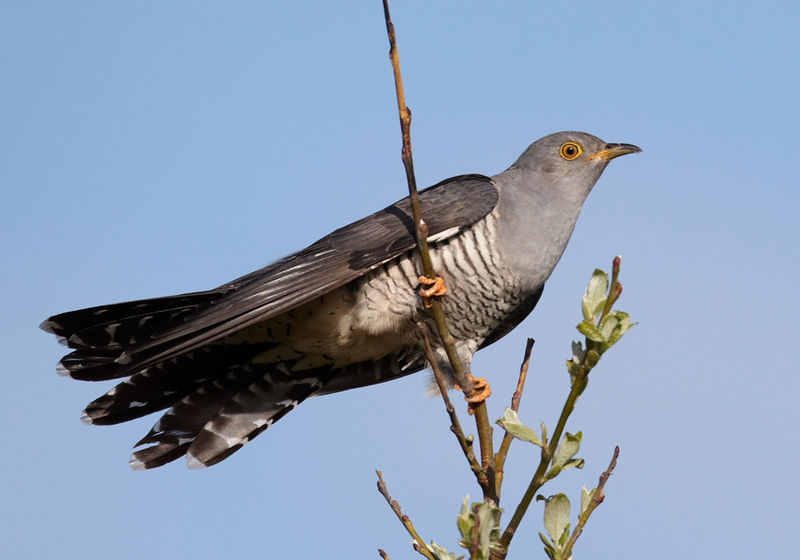
The Common Cuckoo is a medium sized bird belonging to the cuckoo family. It is found in Europe and Asia during summers, migrating to Africa for wintering.
This species has adapted an interesting lifestyle of being a brood parasite – it lays its eggs in other birds’ nests most often that of dunnocks, meadow pipits and reed warblers.
The host bird then incubates the egg as if it were their own which hatches earlier than any other chicks present there thus gaining more attention from the parent birds resulting in better growth rate for Common Cuckoo chicks who are bigger than even their hosts.Scientific classification:
| Kingdom | Animalia |
| Phylum | Chordata |
| Class | Aves |
| Order | Cuculiformes |
| Family | Cuculidae |
| Genus | Cuculus |
| Species | C. canorus |
Also Featured In: Native Birds Of Germany, Common Estonian Birds
13. White Stork
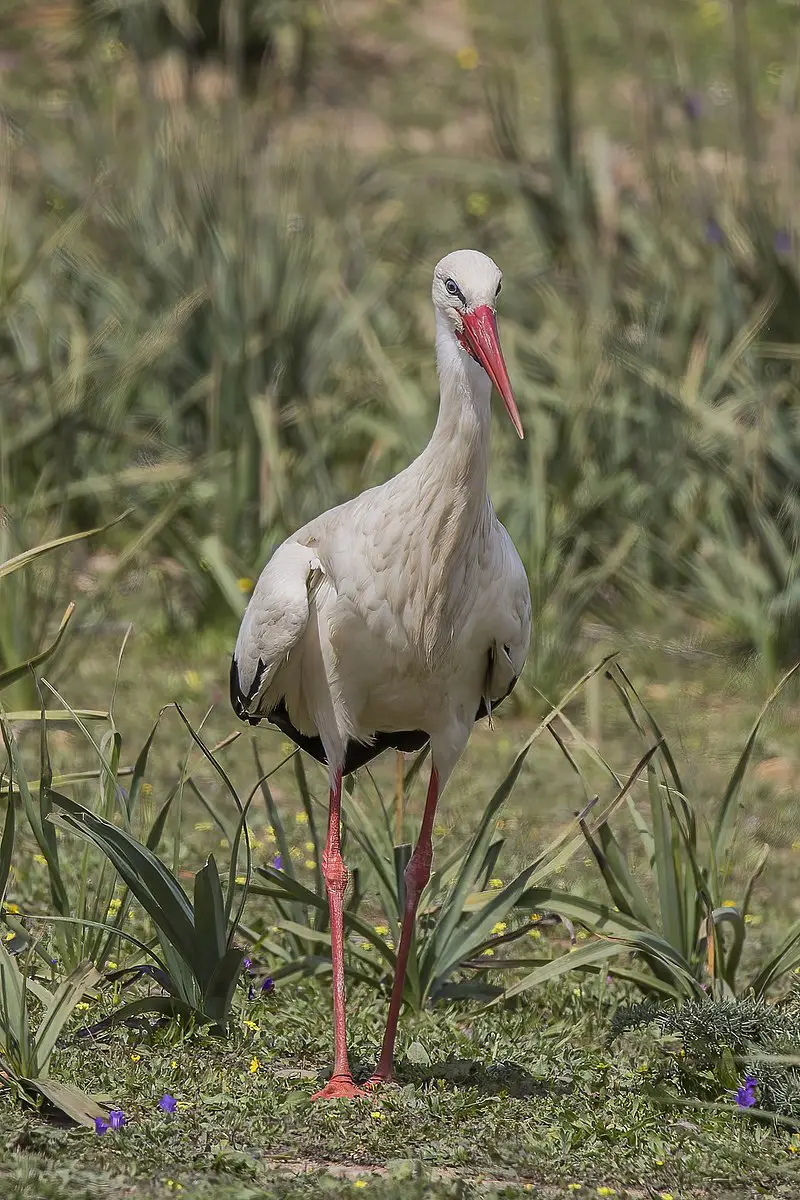
The White Stork is a majestic bird found in Europe, with white plumage and black wings. It has long slender legs and beaks that are usually bright red in color.
The average adult stands around 100 – 115 cm tall from beak to tail tip, while its wing span can reach up to 155-215 cm wide. There are two subspecies of the White Stork which differ slightly by size.
They feed on small animals such as frogs, fish or insects and nest near human dwellings due to the abundance of food available there; they also build nests atop chimneys or roofs when given the chance.
These birds have been revered for centuries as symbols of fertility because their return each spring often coincides with an increase in births among humans living nearby – something superstitious people take great note of.Scientific classification:
| Kingdom | Animalia |
| Phylum | Chordata |
| Class | Aves |
| Order | Ciconiiformes |
| Family | Ciconiidae |
| Genus | Ciconia |
| Species | C. ciconia |
Also Featured In: Amsterdam Birds You Should Know, Common Birds of Portugal
14. Great Crested Grebe
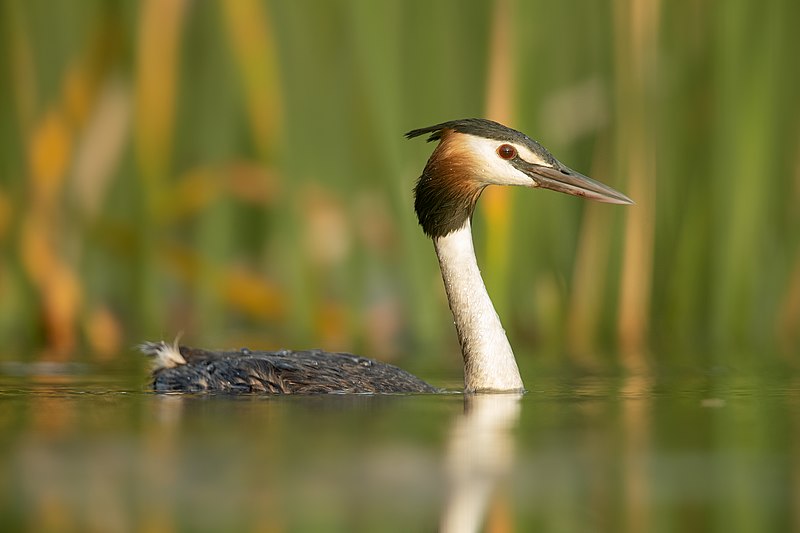
The great crested grebe is a beautiful water bird belonging to the grebe family. It is easily identified by its striking head crest, which it displays during mating rituals.
Originally classified in 1758 by Carl Linnaeus as Colymbus cristatus, this species has since become the type example for all other members of its genus Podiceps.
Great crested grebes are known for their intricate courtship behavior such as synchronized swimming and “head-shaking” motions used to attract mates.
They also possess unique features like red eyes and lobed feet that help them swim efficiently underwater when hunting for food.
The great crested grebe can be found throughout much of Europe, Asia, Africa and Australasia where they inhabit freshwater wetlands or shallow lakeshores with plenty of vegetation nearby to hide from predators while nestingScientific classification:
| Kingdom | Animalia |
| Phylum | Chordata |
| Class | Aves |
| Order | Podicipediformes |
| Family | Podicipedidae |
| Genus | Podiceps |
| Species | P. cristatus |
Also Featured In: Common Birds in London, Common Birds Found near Ishigaki
15. Northern Goshawk
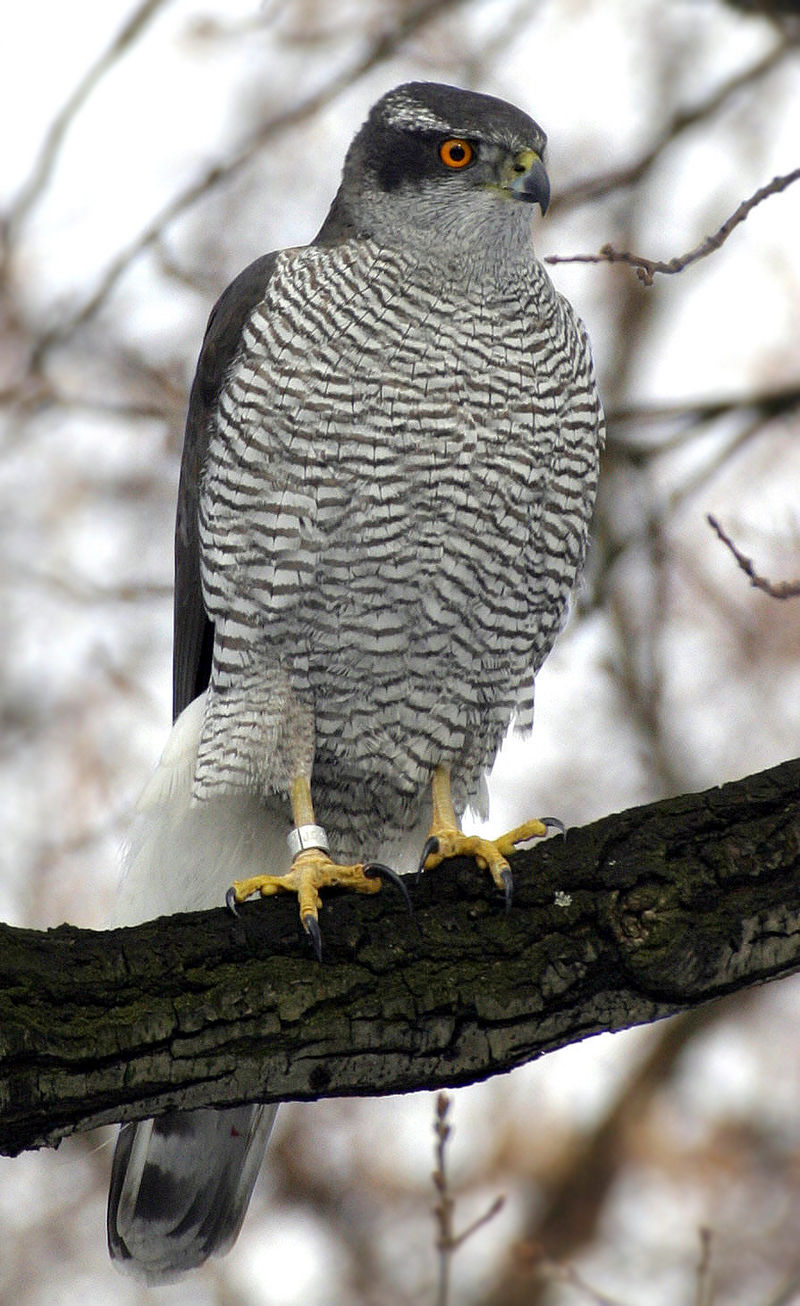
The Northern Goshawk is a medium-large bird of prey belonging to the Accipitridae family. It has been known as one of the true hawks, with “Accipiter” meaning hawk in Latin and “gentilis” referring to its noble characteristics.
They are found worldwide, most commonly in wooded areas such as forests or thickets where they hunt small birds and mammals.
The males have spotted grey upperparts while females tend to be fully brown above with some lighter barring on their underparts.
These raptors rely heavily on speed and agility when hunting from either perches or during aerial dives at high speeds for their prey which makes them formidable predators that can reach up to 40 mph.Scientific classification:
| Kingdom | Animalia |
| Phylum | Chordata |
| Class | Aves |
| Order | Accipitriformes |
| Family | Accipitridae |
| Genus | Accipiter |
| Species | A. gentilis |
Also Featured In: Common Birds in the Cities, Common Birds in Alberta
16. Barn Owl
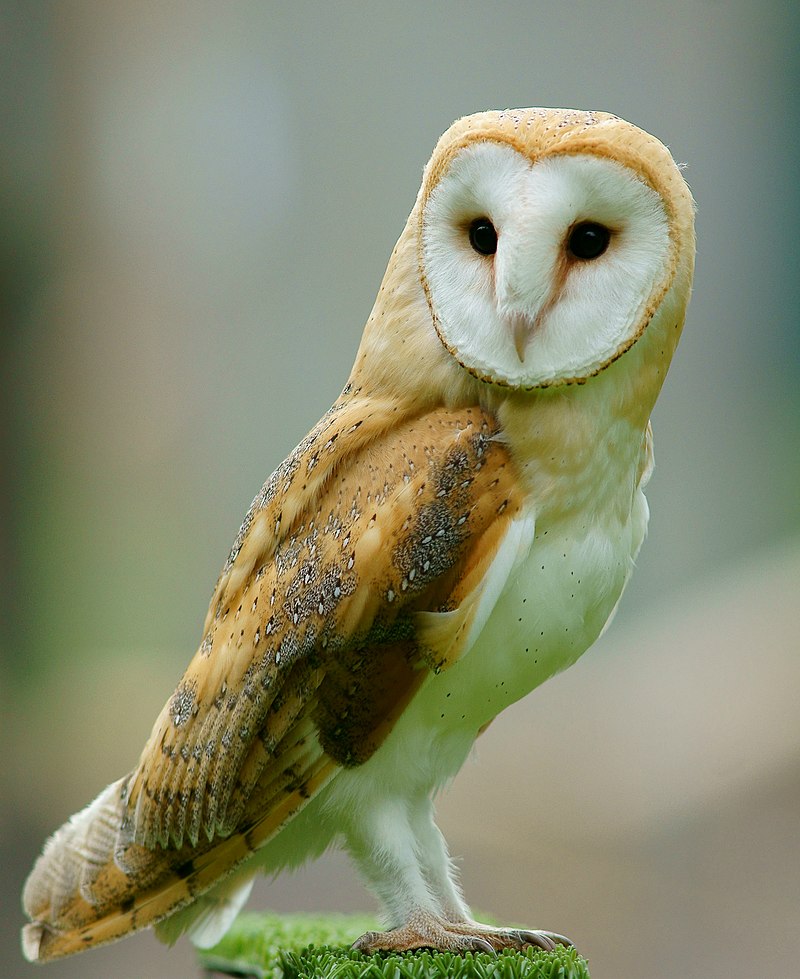
Barn owls are a beautiful and fascinating species of birds found around the world, with the exception of polar and desert regions, most of Indonesia and some Pacific Islands.
They have large eyes, thin legs and long wings that help them to hunt silently in low light conditions.
Their white colouring helps them blend into their surroundings making it easier for them to catch prey.
Barn owls are nocturnal hunters who use their impressive hearing capabilities to locate rodents moving within vegetation or tunnels beneath the ground.
They also feed on insects such as beetles, moths etc., which they can detect from high up in flight using their excellent vision even at night time.
The barn owl plays an important role in balancing ecosystems by controlling rodent populations which is why they should be protected wherever possible so that this vital service continues uninterruptedly.Scientific classification:
| Kingdom | Animalia |
| Phylum | Chordata |
| Class | Aves |
| Order | Strigiformes |
| Family | Tytonidae |
| Genus | Tyto |
| Species | T. alba |
Also Featured In: Famous Paintings Birds, Flight Birds You Should Know
17. Black Grouse
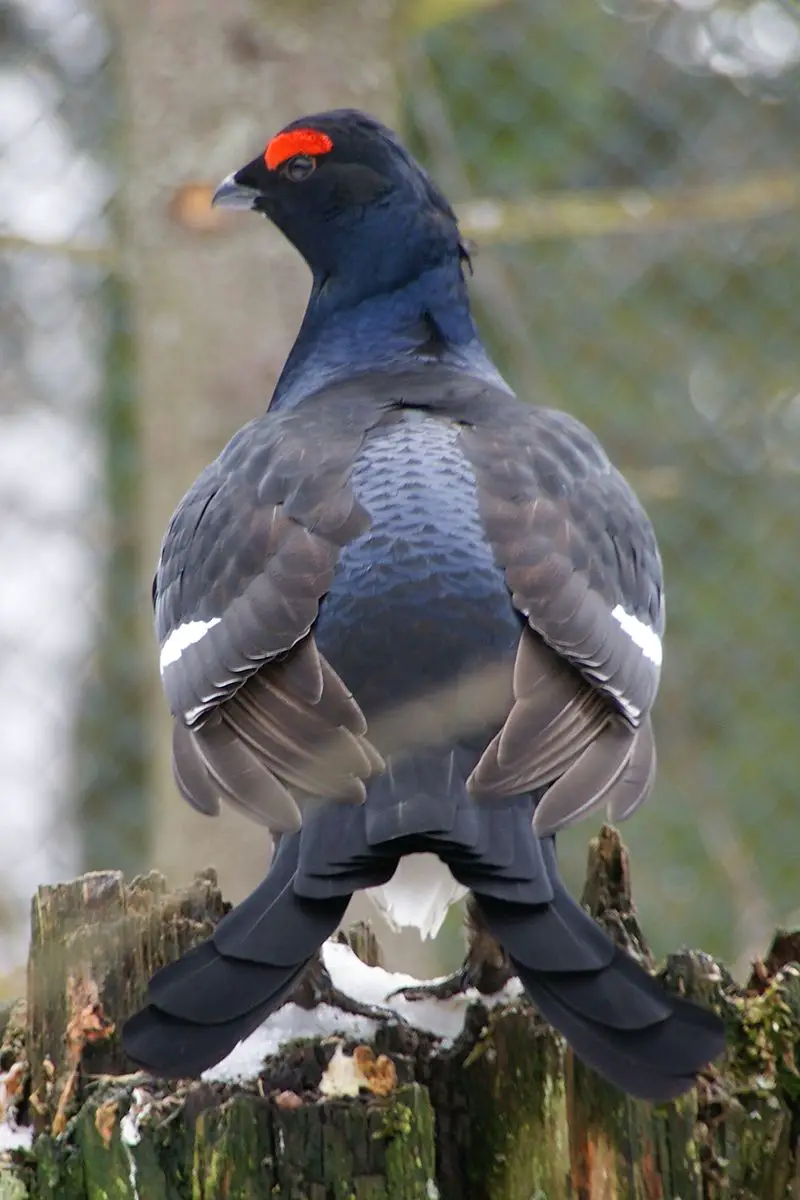
The black grouse is a large bird in the grouse family. It lives mainly in moorland and steppe habitats, often near wooded areas. In winter, it moves to dense forests where its diet consists almost exclusively of conifer needles.
These birds have an impressive wingspan of up to 75 cm wide, with males boasting dark metallic plumage and white tail feathers that they display during courtship rituals known as ‘leks’. Females are smaller than males with more brownish-grey coloured feathers.
Both sexes possess red combs above their eyes which become brighter during mating season – along with yellow wattles on their throats.
The black grouse is considered vulnerable due to loss of habitat caused by human activity such as deforestation and agricultural practices.Scientific classification:
| Kingdom | Animalia |
| Phylum | Chordata |
| Class | Aves |
| Order | Galliformes |
| Family | Phasianidae |
| Genus | Lyrurus |
| Species | L. tetrix |
Also Featured In: Birds of Wales: Exploring Diverse Habitats and Conservation Efforts,
18. Common Snipe
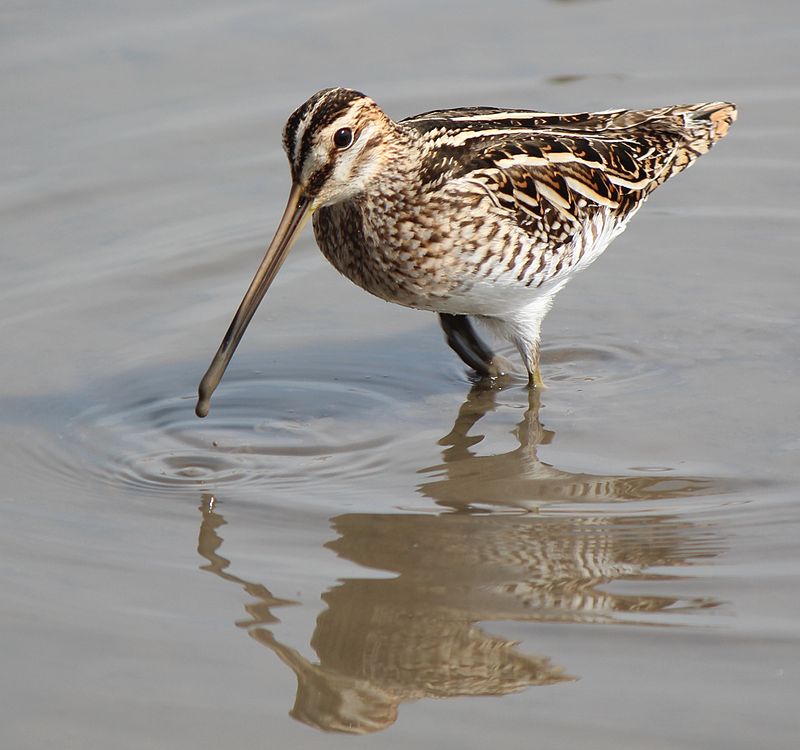
The Common Snipe is a small wader bird that can be found throughout the Palearctic region, from Iceland to northern Russia and Siberia. It breeds in marshes, bogs, tundra and wet meadows during summertime.
Its diet consists of earthworms and insects which it finds by probing with its long bill into soft ground.
During winter months they migrate southwards in search of more favourable conditions for breeding; however their exact migration routes remain unknown.
These birds are fairly secretive but can often be seen skulking around wetlands using their cryptic mottled brown plumage as camouflage against predators.
They have an unmistakable flight pattern – rapid bursts of wing-beats interspersed with glides – making them one of the most distinctive species on our planet.Scientific classification:
| Kingdom | Animalia |
| Phylum | Chordata |
| Class | Aves |
| Order | Charadriiformes |
| Family | Scolopacidae |
| Genus | Gallinago |
| Species | G. gallinago |
Also Featured In: Tokyo Birds You Need to Know,
19. Eurasian Wryneck
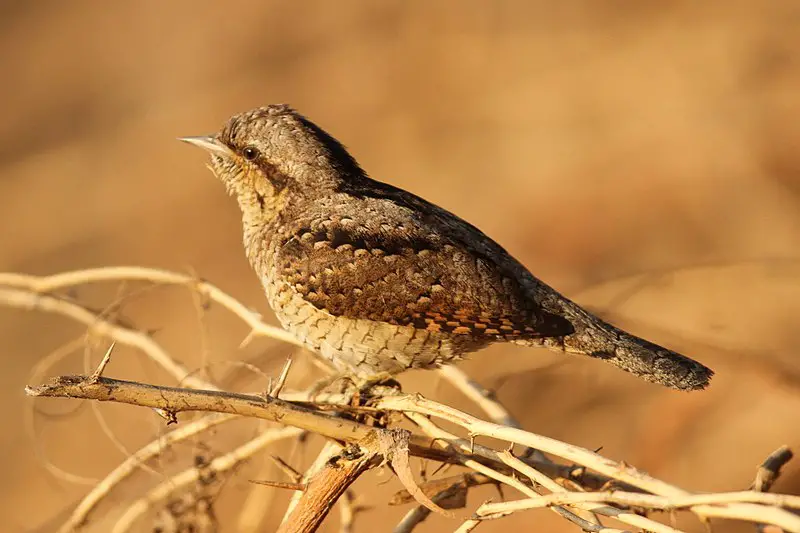
The Eurasian Wryneck is a species of woodpecker found in temperate regions of Europe and Asia. They breed during the summer months, but migrate south to tropical Africa or southern Asia for winter.
These birds are quite adaptable when it comes to their habitat, as they can be seen in open countryside, woodland, orchards and gardens alike.
To identify them you should look out for their distinctive brownish-grey feathers with black bars on the wings and tail; males also have red markings around their neck too.
Their diet consists mainly of insects which they find by probing into loose bark on trees or digging through soil with its sharp bill.
All in all an amazing bird that deserves more attention.Scientific classification:
| Kingdom | Animalia |
| Phylum | Chordata |
| Class | Aves |
| Order | Piciformes |
| Family | Picidae |
| Genus | Jynx |
| Species | J. torquilla |
Also Featured In: Hong Kong Birds You Need to See, Urban Birds of Hong Kong
20. Eurasian Curlew
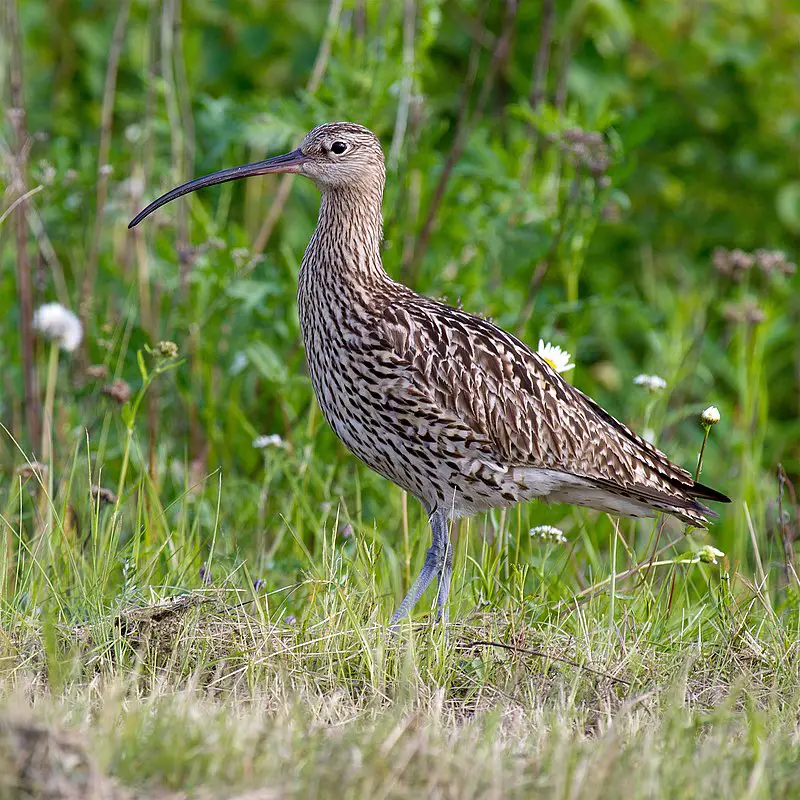
The Eurasian curlew is a wader bird belonging to the Scolopacidae family. It has an incredibly wide range, breeding across temperate Europe and Asia. This species can be easily identified by its long, curved bill and distinctive white underparts.
The male’s head typically appears striped while the female’s tends to be mottled brown in coloration with dark streaks on her neck and breast feathers.
With wingspans of almost two feet, these birds are quite large compared to other members of their genus.
Despite being so widespread they remain vulnerable due to ongoing habitat loss or degradation as well as hunting practices along migration routes or during wintering grounds visits.Scientific classification:
| Kingdom | Animalia |
| Phylum | Chordata |
| Class | Aves |
| Order | Charadriiformes |
| Family | Scolopacidae |
| Genus | Numenius |
| Species | N. arquata |
Also Featured In: Birds of Orkney,
21. White-Tailed Eagle
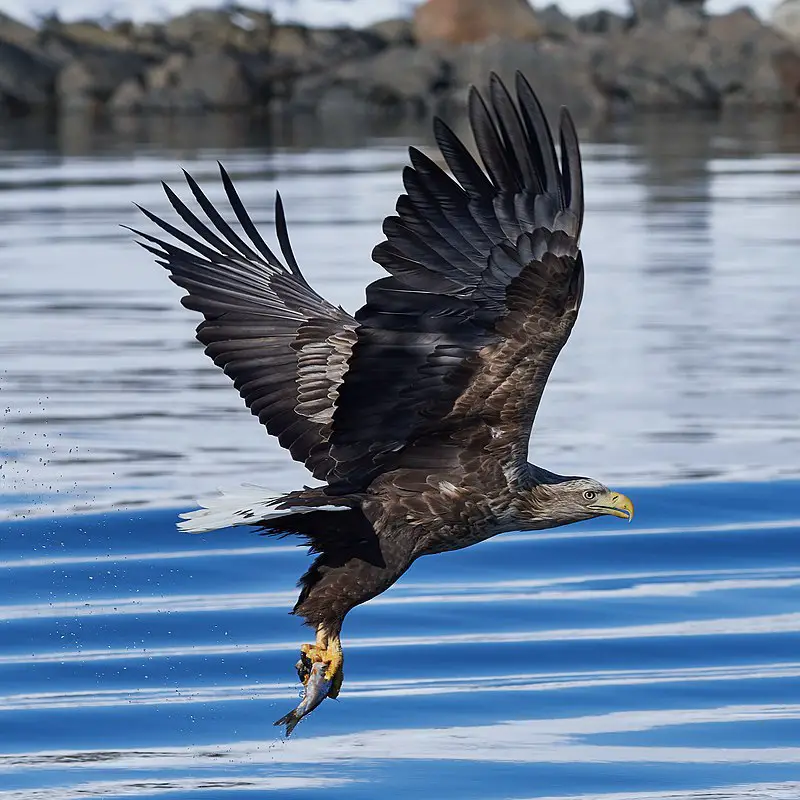
The white-tailed eagle is an impressive species of sea eagle found across temperate Eurasia. This majestic bird belongs to the family Accipitridae, which includes hawks, kites and harriers.
It has a wingspan of up to 2.5 meters and can weigh 4 kilograms or more.
The plumage varies in colour from dark brown above with paler head and neck while its tail is pure white – hence it’s name.
They feed mainly on fish but will also take small mammals, birds and carrion when available.
White-tailed eagles are solitary by nature but form pairs during nesting season typically near bodies of water such as lakes or coasts where they build large stick nests on trees or cliffsides for their young ones to hatch safely in peace.Scientific classification:
| Kingdom | Animalia |
| Phylum | Chordata |
| Class | Aves |
| Order | Accipitriformes |
| Family | Accipitridae |
| Genus | Haliaeetus |
| Species | H. albicilla |
Also Featured In: Birds of United Kingdom, Birds You’ll Find in Hokkaido
22. Western Capercaillie
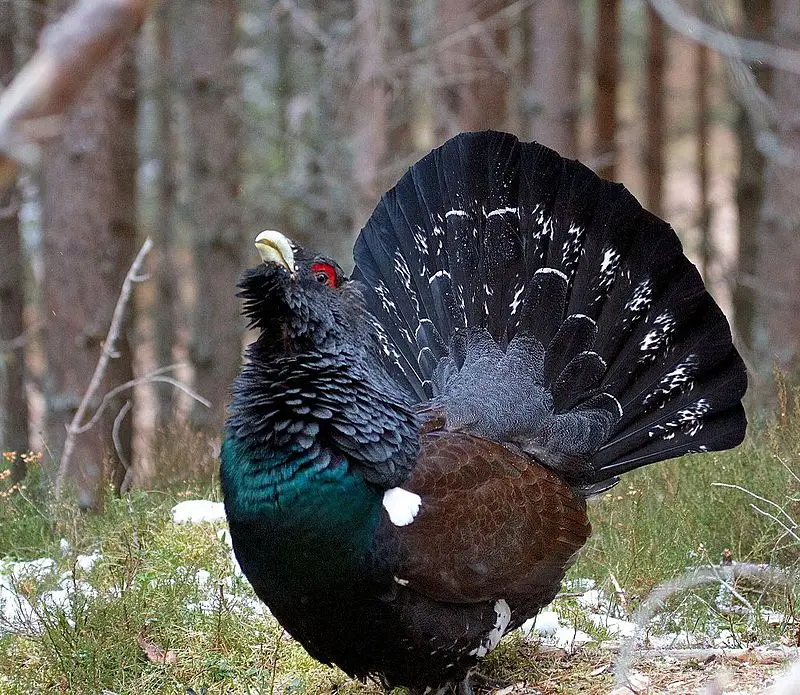
The Western Capercaillie is the largest bird among all grouse species. It has a wingspan of around 2 to 3 feet and can weigh up to 16 pounds. Its body is covered in rich, dark brown feathers which have light speckles throughout them.
This beautiful bird inhabits parts of Europe and the Palearctic region where it feeds on berries, seeds and buds from trees like birch and pine.
In winter months they’ll also eat mushrooms when available too. They live in forests with plenty of dense vegetation so that they can hide away from predators when necessary.
During mating season males will perform elaborate courtship displays to attract females – making this one amazing creature indeed.Scientific classification:
| Kingdom | Animalia |
| Phylum | Chordata |
| Class | Aves |
| Order | Galliformes |
| Family | Phasianidae |
| Genus | Tetrao |
| Species | T. urogallus |
Also Featured In: Birds of Poland, Birds You’ll Find in Albania
23. Eurasian Coot
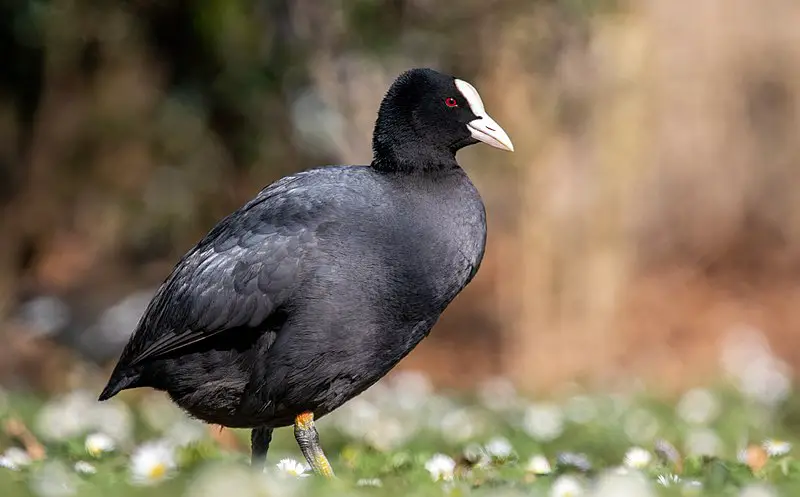
The Eurasian Coot is a water bird belonging to the Rallidae family. It has an overall slaty-black body with a glossy black head and white bill, along with a white frontal shield.
Both male and female coots look similar in appearance. This species can be found across Europe, Asia, Australia, New Zealand and parts of North Africa – making it quite widespread.
In terms of behavior they usually feed on aquatic plants as well as insects while swimming or walking on land near bodies of water such as ponds or lakes.
They are also known for their aggressive nature when defending nesting sites from other birds during breeding season.Scientific classification:
| Kingdom | Animalia |
| Phylum | Chordata |
| Class | Aves |
| Order | Gruiformes |
| Family | Rallidae |
| Genus | Fulica |
| Species | F. atra |
Also Featured In: Water Birds Live around Us, Birds that Commonly Found in Pond
24. Corn Crake
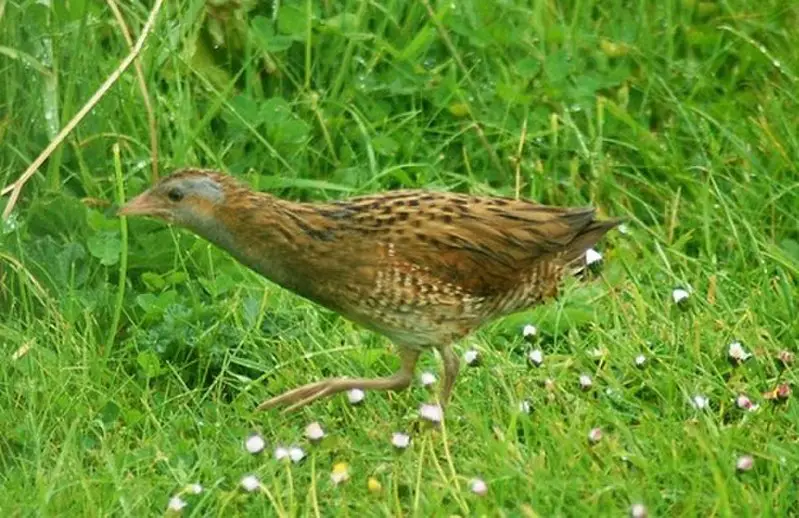
The Corn Crake is a species of rail that inhabits Europe and Asia, migrating to Africa for the winter.
It’s medium-sized with buff or grey streaked brownish black upperparts and blue-grey underparts that are decorated with rust colored bars along its flanks and undertail.
They prefer moist meadows, grasslands, marshes, bogs and moorland where they can find their food sources such as seeds, leaves shoots insects worms spiders etc.
In the summer it may be heard singing from tall vegetation at night when looking for mates but during day time it will hide in thick cover making them difficult to spot.
The corn crake has been listed by IUCN as near threatened due Conservation efforts have helped increase numbers but ongoing threats such as habitat loss still remain an issue so continued effort must be made if this unique bird is to survive into future generations.Scientific classification:
| Kingdom | Animalia |
| Phylum | Chordata |
| Class | Aves |
| Order | Gruiformes |
| Family | Rallidae |
| Genus | Crex Bechstein, 1803 |
| Species | C. crex |
Also Featured In: Birds of Latvia, Birds Commonly Found in Northern Ireland
25. Eurasian Three-Toed Woodpecker
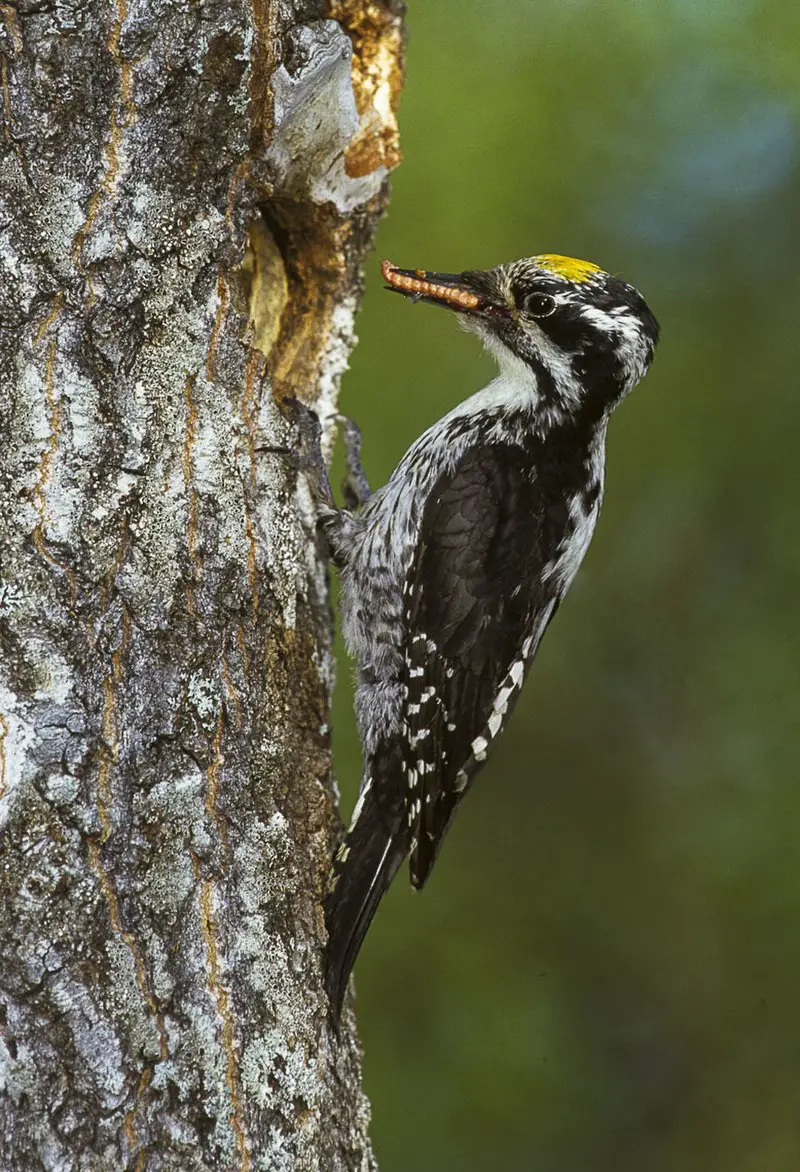
The Eurasian three-toed woodpecker is a beautiful medium sized bird found from northern Europe to Japan.
It was first formally described by Swedish naturalist Carl Linnaeus in 1758 and has since become an iconic species due to its distinctive black, white and red plumage as well as its adaptations for living in cold climates.
The Eurasian three-toed woodpecker lives mainly on coniferous trees such as spruce or fir, where it finds insect larvae under the bark of deadwood which forms part of its diet.
Its most recognizable feature is the bright yellow stripe running down each side of its head, making it easy to identify even at great distances.
This shy but tough creature can survive subzero temperatures with ease thanks to their thick feathers and specialised feet that allow them to cling onto icy branches.Scientific classification:
| Kingdom | Animalia |
| Phylum | Chordata |
| Class | Aves |
| Order | Piciformes |
| Family | Picidae |
| Genus | Picoides |
| Species | P. tridactylus |
26. Ural Owl
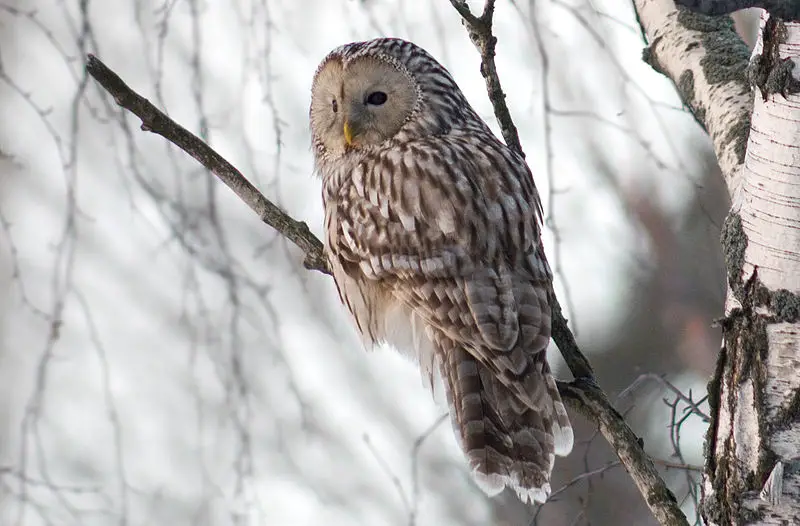
The Ural owl is a majestic nocturnal bird of the Strigidae family. It has an impressive wingspan, usually between 28 to 38 inches wide.
This species can be seen throughout much of Eurasia, from northern Scandinavia and Scotland all the way east across Russia into Korea and Japan; it even reaches southern parts of Mongolia.
The Ural owl sports brown feathers with white spots that help it blend in with its environment during the day making it difficult for predators or humans alike to spot them easily.
These owls also have large yellow eyes which helps them hunt better at night by being able to see their prey more clearly in dim light conditions.
All these features combined make the Ural owl one truly remarkable creature.Scientific classification:
| Kingdom | Animalia |
| Phylum | Chordata |
| Class | Aves |
| Order | Strigiformes |
| Family | Strigidae |
| Genus | Strix |
| Species | S. uralensis |
27. Sylviid Warblers
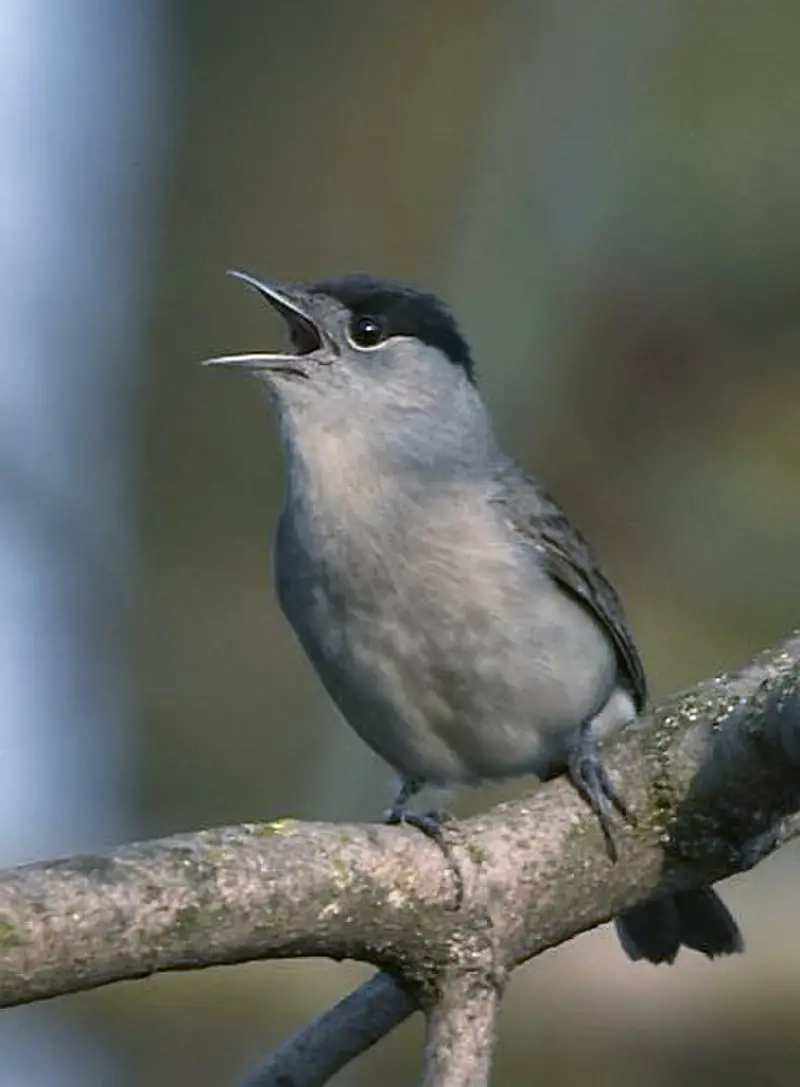
The Sylviid warblers are a family of passerine birds found in Eurasia and Africa. They include the typical warblers as well as babblers that were formerly part of the Old World babbler family.
These birds have slender bodies, pointed wings, long tails and strong legs adapted for ground-dwelling habits like running or hopping along branches.
The male often has bright colors while females are usually duller in coloration with more muted plumage patterns than males.
Some species also show sexual dimorphism where one sex may be larger or smaller than its counterpart; for instance some species may have longer tail feathers on the female side compared to their male counterparts.
Many members of this group feed on insects but some specialize on seeds, fruits, nectar or even frogs.Scientific classification:
| Kingdom | Animalia |
| Phylum | Chordata |
| Class | Aves |
| Order | Passeriformes |
| Superfamily | Sylvioidea |
| Family | Sylviidae Leach, 1820 |
Also Featured In: Birds of Morocco, Birds That Live in Iraq
28. Treecreepers
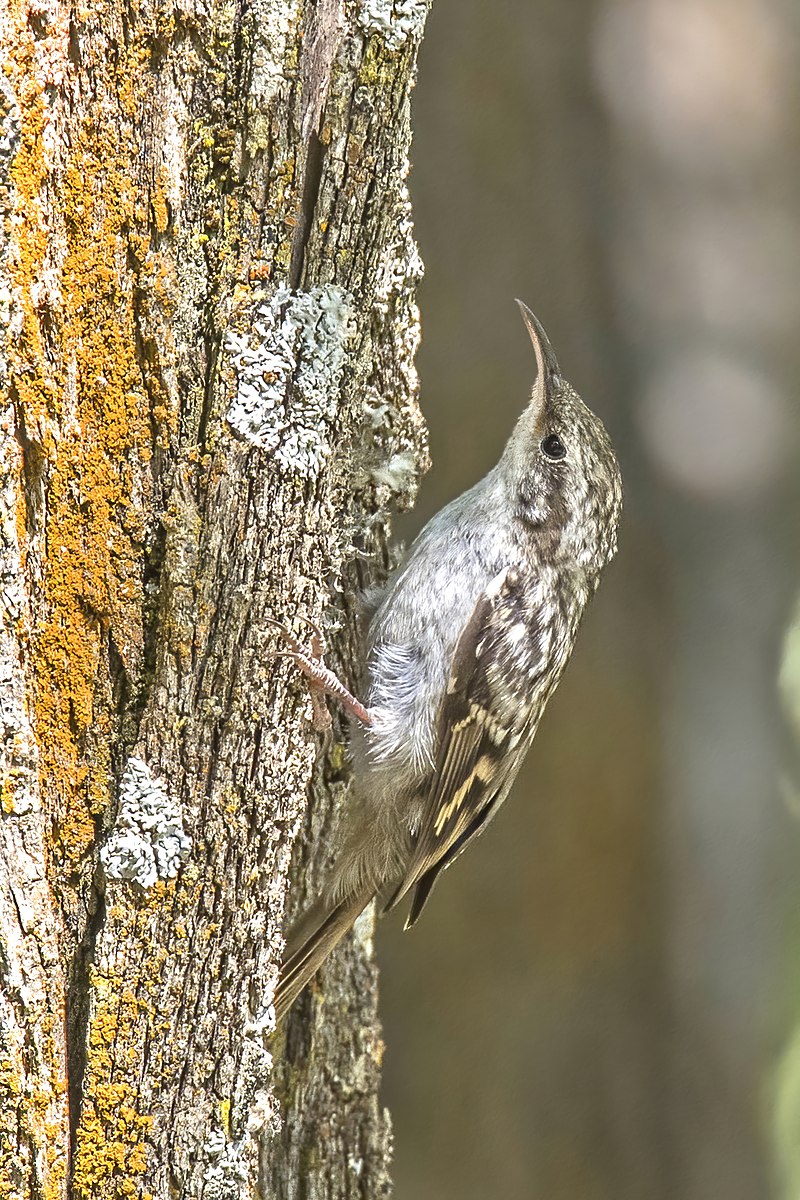
Treecreepers are small passerine birds found in wooded areas of the Northern Hemisphere and sub-Saharan Africa.
They have dull colored plumage, long curved bills, stiff tails and strong feet that help them to climb up tree trunks while searching for food such as insects and spiders.
The two genera Certhia and Salpornis include eleven species which can be identified by their distinct call – a high pitched ‘tsee-tsit’.
Treecreepers build cup shaped nests on trees usually near the base or middle trunk using mosses, lichens, grasses with leaves inside them to provide insulation from cold temperatures.
These birds also use bark crevices during winter months when they shelter in groups together against extreme weather conditions.Scientific classification:
| Kingdom | Animalia |
| Phylum | Chordata |
| Class | Aves |
| Order | Passeriformes |
| Superfamily | Certhioidea |
| Family | Certhiidae Leach, 1820 |
Also Featured In: Flocks Birds around Us, Birds that Live in Croatia
29. Common Pochard
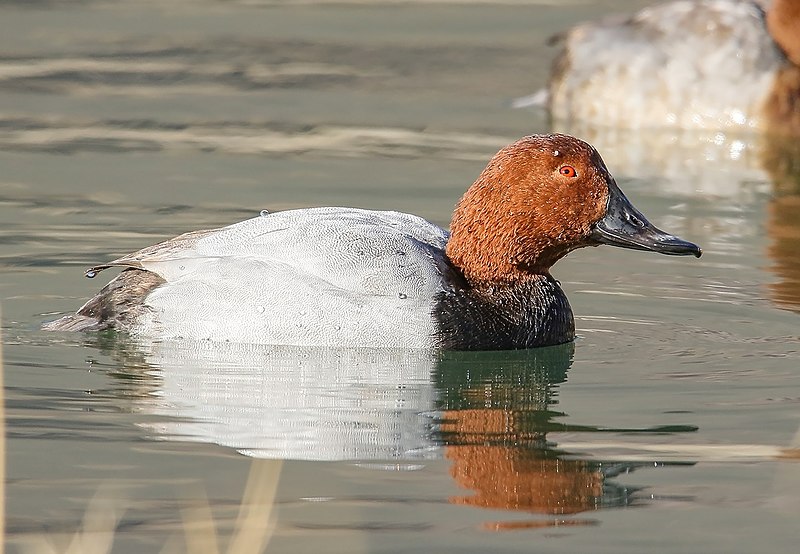
The Common Pochard is a medium-sized diving duck found across Eurasia and North Africa. It has distinctive features such as a long, dark bill with a grey band, red head and neck, black breast, red eyes and grey back.
The female has similar characteristics but her head is more brown/grey in colour than the male’s striking red hue.
They are often seen swimming together in large flocks near freshwater bodies or on lakes to feed on aquatic plants like seeds of waterlilies etc., which makes them an important part of the ecosystem by helping disperse plant species.
Their loud call can be heard over vast distances making them easy to spot even when they’re far away.Scientific classification:
| Kingdom | Animalia |
| Phylum | Chordata |
| Class | Aves |
| Order | Anseriformes |
| Family | Anatidae |
| Genus | Aythya |
| Species | A. ferina |
Also Featured In: Common Birds in Saudi Arabian, Common Birds of Itsukushima
30. Black-Tailed Godwit
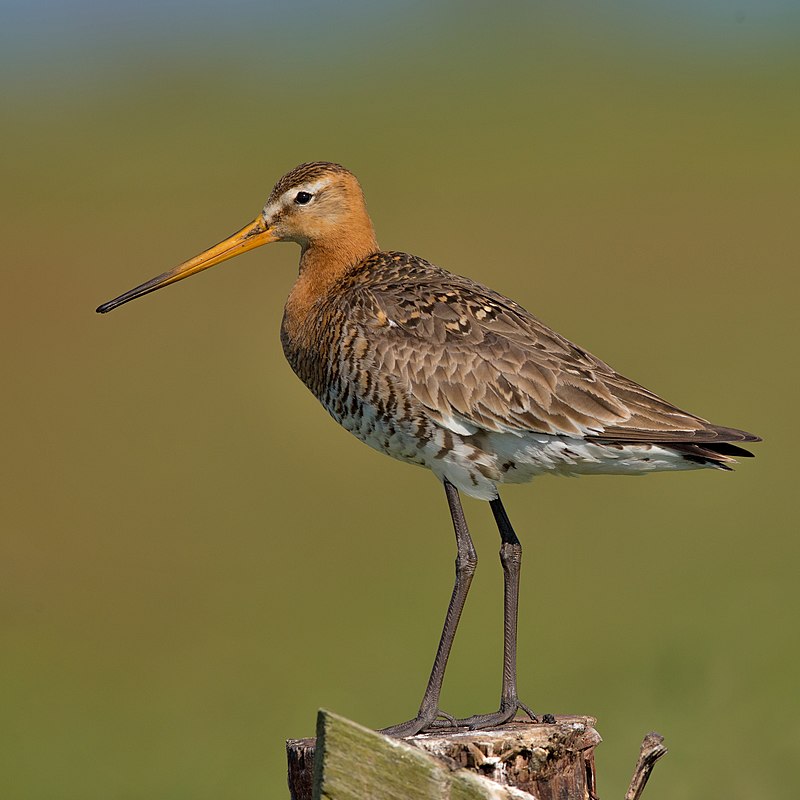
The Black-tailed Godwit is a species of large shorebird that was first described by Carl Linnaeus in 1758.
These beautiful birds have an orange head, neck and chest during breeding season while they turn to grey-brown coloration in winter.
They are easily identifiable due their black and white wingbar throughout the year. As for its habitat, these godwits breed mostly on Iceland but also across Europe, eastward through Asia Minor all the way to Mongolia; some even winter further south in Africa or India.
The Godwit has adapted well to human presence as it can be found close to wetlands near farms or villages where plenty of food is available from ploughed fields.
It’s really amazing how such a majestic bird with colorful plumage manages so successfully at this day and age.Scientific classification:
| Kingdom | Animalia |
| Phylum | Chordata |
| Class | Aves |
| Order | Charadriiformes |
| Family | Scolopacidae |
| Genus | Limosa |
| Species | L. limosa |
Also Featured In: Birds in Sri Lanka, Estuaries Birds
31. Ruff
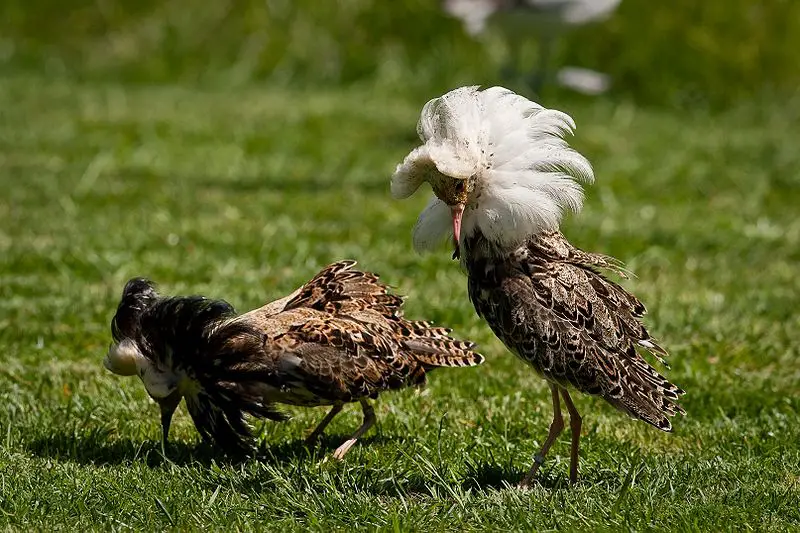
The Ruff is a medium-sized wading bird found in wetlands across northern Eurasia. It has an unmistakable appearance, with its long neck and pot belly body combined with bright plumage of males contrasting the duller browns of females.
During breeding season, males have unique feathers that form a ruff around their head which gave them their name.
This species displays sexual dimorphism; male Ruffs are much more colourful than female counterparts and they also develop longer bills during mating season to show off to potential mates.
Migratory by nature, huge flocks can be seen on winter grounds like Europe, Africa, Asia and Australia before returning back north for summer months when food sources become abundant again.Scientific classification:
| Kingdom | Animalia |
| Phylum | Chordata |
| Class | Aves |
| Order | Charadriiformes |
| Family | Scolopacidae |
| Genus | Calidris |
| Species | C. pugnax |
Also Featured In: Birds of Netherlands, Large African Birds You Need to Know
32. Motacillidae
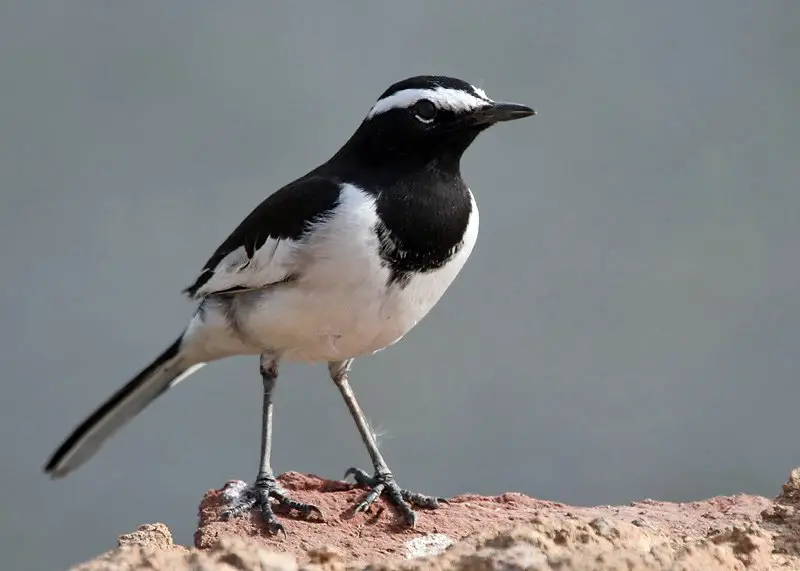
Motacillidae is a family of small passerine birds consisting of around 70 species. They are found across Europe, Africa, Asia and even Alaska with two migratory breeding species.
The three genera they belong to include wagtails which typically have medium to long tails; longclaws that can only be spotted in the Afrotropics; and pipits which possess the most cosmopolitan distribution worldwide.
These birds feed on insects as well as seeds for their diets and are usually seen in open habitats such grasslands or wetlands where food sources like invertebrates can easily be accessed.
Most Motacillidae species also use mud nests during breeding season making them easy targets for predators so it’s important we protect these beautiful creatures.Scientific classification:
| Kingdom | Animalia |
| Phylum | Chordata |
| Class | Aves |
| Order | Passeriformes |
| Superfamily | Passeroidea |
| Family | Motacillidae Horsfield, 1821 |
Also Featured In: Birds of Belgium, Birds You’ll Find in Moldova
33. Eurasian Bittern
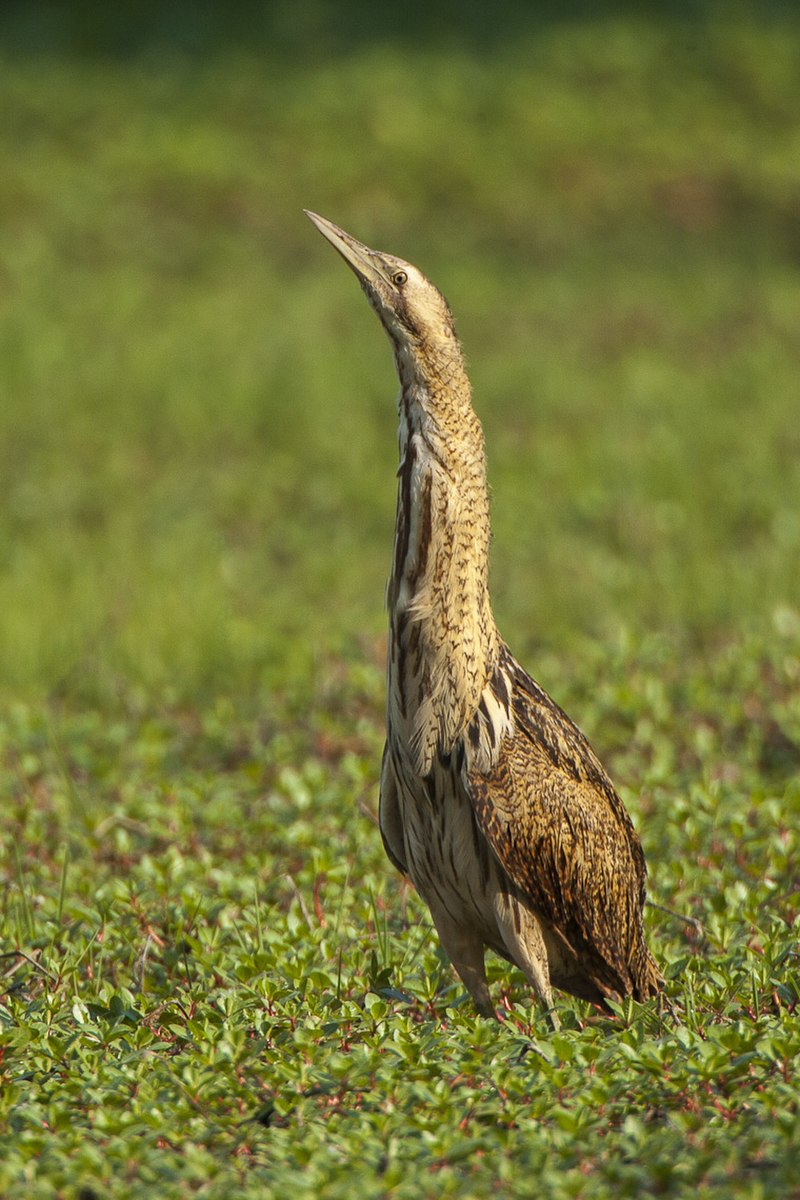
The Eurasian Bittern is a large and secretive wading bird of the heron family. It has two subspecies, one found in Europe and northern Africa, while another can only be seen in parts of southern Africa.
This migratory species spends its winters southwards from its breeding grounds across much of Europe to eastern Asia as far south as China.
The male bitterns are easily identifiable by their loud booming calls that they make during mating season which is usually between April-May.
They have brown striped plumage with lighter underparts which helps them blend into marshy habitats where they feed on fish and amphibians among other prey items.
Despite having a relatively wide distribution range, this species remains threatened due to habitat destruction caused by human activities such as wetland drainage for agricultural use or development projects like dams etc., making conservation efforts necessary for securing their future survival.Scientific classification:
| Kingdom | Animalia |
| Phylum | Chordata |
| Class | Aves |
| Order | Pelecaniformes |
| Family | Ardeidae |
| Genus | Botaurus |
| Species | B. stellaris |
Also Featured In: Birds of Czech Republic, Birds That Live in Anglesey
34. Pallas’s Sandgrouse
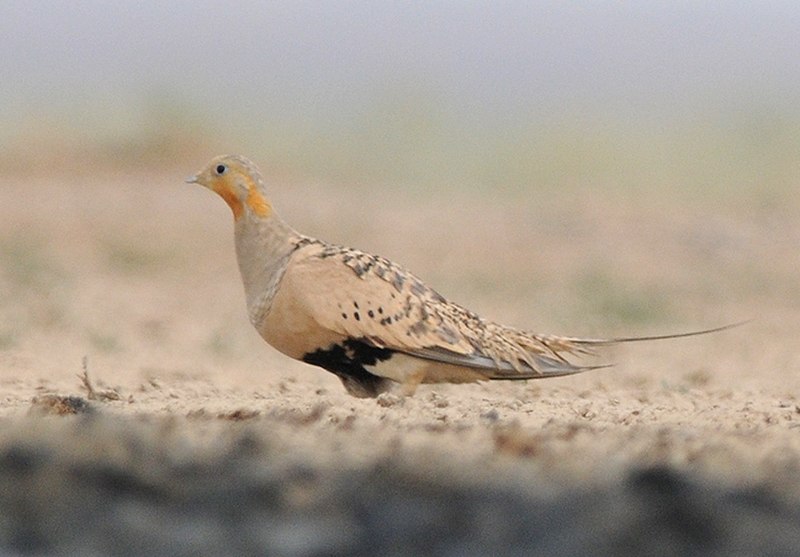
Pallas’s sandgrouse is a medium to large bird in the sandgrouse family and named after German zoologist Peter Simon Pallas. It was first mentioned by Marco Polo around 1300 as Bargherlac, from Turkmen bağırlak.
Its scientific name, Syrrhaptes paradoxus (S. pallasii), comes from Ancient Greek words meaning ‘paradoxical plover’.
This species has several distinctive features: it prefers open habitats with sparse vegetation.
Its wings are short but powerful for fast flight; and males have special feathers on their belly that can soak up water which they later transfer to chicks or other members of the flock via special tongue movements.
These fascinating birds are an important part of our natural history and should be appreciated for all they bring us.Scientific classification:
| Kingdom | Animalia |
| Phylum | Chordata |
| Class | Aves |
| Order | Pterocliformes |
| Family | Pteroclidae |
| Genus | Syrrhaptes |
| Species | S. paradoxus |
35. Crested Lark
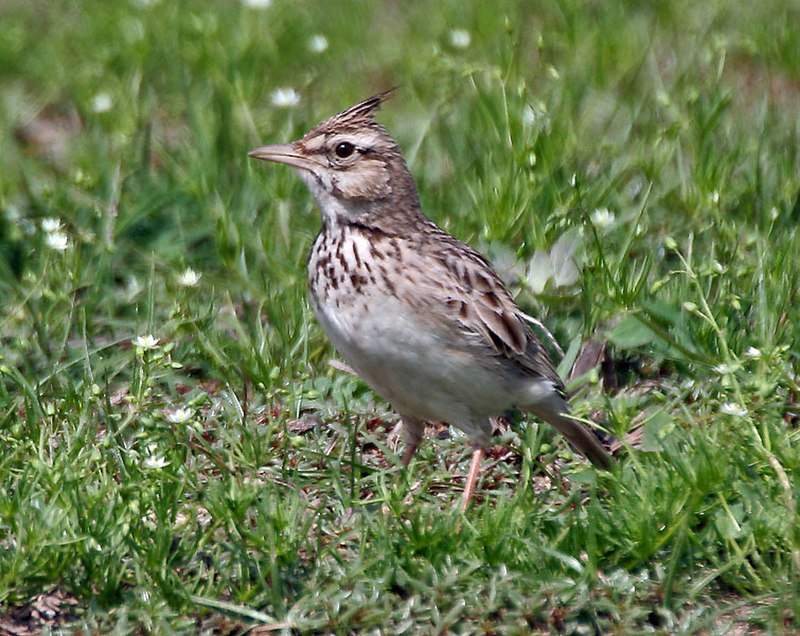
The Crested Lark is a species of lark that can be found across Eurasia and northern Africa. This non-migratory bird rarely appears as a vagrant in Great Britain.
It was originally described by Carl Linnaeus in 1758 for his 10th edition of Systema Naturae, under the genus Alauda until German naturalist Friedr Merrem moved it to its own genus Galerida in 1804.
The Crested Lark has an overall sandy color with darker brown wings and back, white underside, dark tail feathers and blackish bill.
Its most distinguishing feature are the two tufts on either side of its head which gives this species its name.Scientific classification:
| Kingdom | Animalia |
| Phylum | Chordata |
| Class | Aves |
| Order | Passeriformes |
| Family | Alaudidae |
| Genus | Galerida |
| Species | G. cristata |
Also Featured In: Common Birds of the Jordan, Birds Live in Tunisia
36. Northern Gannet
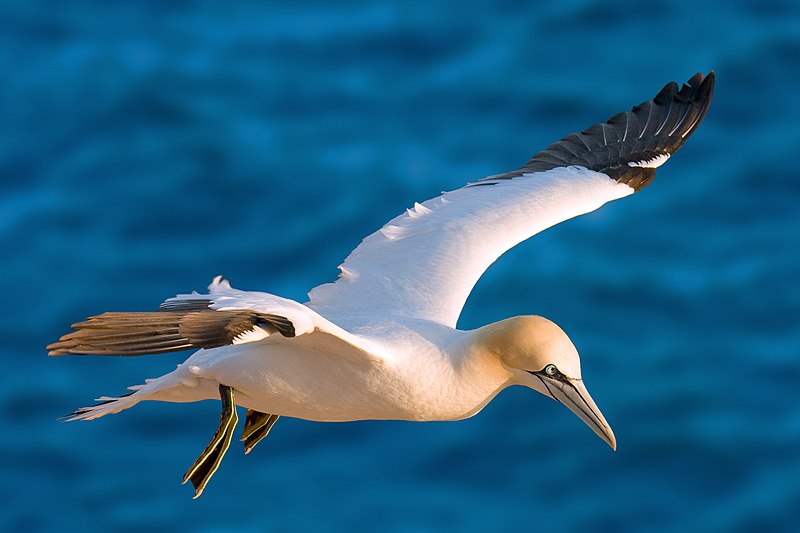
The Northern Gannet is the largest species of seabird in the northern Atlantic, with a white body and long neck.
It has yellowish head feathers and black tipped wings that can reach up to 6 feet across when fully extended.
The beak is large and orange-yellow in color. This bird breeds along western Europe’s coasts as well as northeastern North America.
They forage for fish by plunging into the sea from high above, making them an impressive sight to behold on any given day.
Their diet consists mainly of herring, mackerels or sand eels which they catch midair after diving at speeds reaching over 100 miles per hour.
With their striking features these birds are truly majestic creatures that have been around since prehistoric times – a testament to their hardiness and adaptability.Scientific classification:
| Kingdom | Animalia |
| Phylum | Chordata |
| Class | Aves |
| Order | Suliformes |
| Family | Sulidae |
| Genus | Morus |
| Species | M. bassanus |
Also Featured In: Birds found in portugal, Birds You’ll Find in the Sea
37. Little Bittern
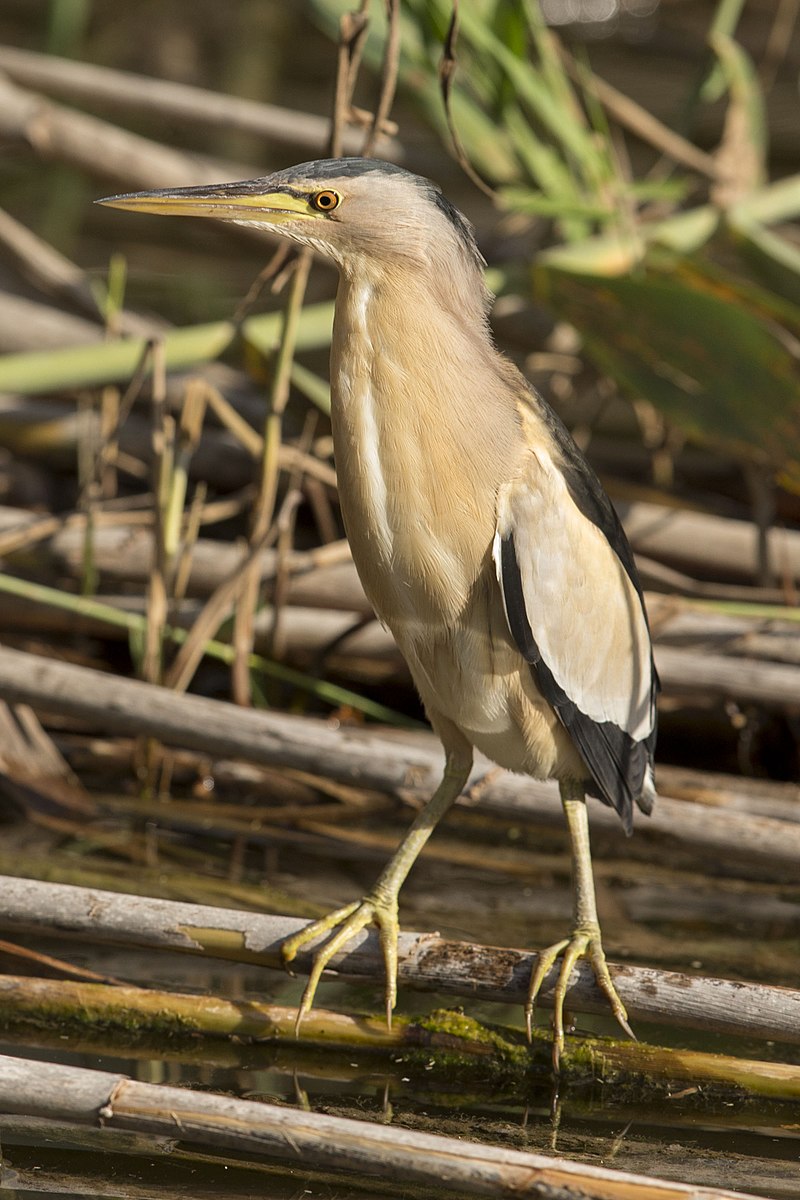
The Little Bittern is a wading bird in the heron family, Ardeidae. Its scientific name Ixobrychus minutus comes from Ancient Greek ixias and Latin for “small” respectively.
It breeds across Africa, central and southern Europe, western and southern Asia as well as Madagascar.
The Little bittern has an orange-brown back with streaks of black while its underside is white with dark stripes running down it sides giving it excellent camouflage to hide amongst reeds or tall grasses near shallow water bodies such as wetlands where they search for food like fish, frogs etc..
They are usually very shy birds but during mating season males make loud croaking calls that can be heard up to 400m away.
These beautiful little creatures have sadly been classified by International Union for Conservation of Nature (IUCN) Red List of Threatened Species due their declining population caused mainly by habitat destruction through agricultural practices or draining of wetland areas which leads to loss if nesting sites putting them at risk.Scientific classification:
| Kingdom | Animalia |
| Phylum | Chordata |
| Class | Aves |
| Order | Pelecaniformes |
| Family | Ardeidae |
| Genus | Ixobrychus |
| Species | I. minutus |
Also Featured In: Most Popular Birds in Mallorca,
38. Garganey
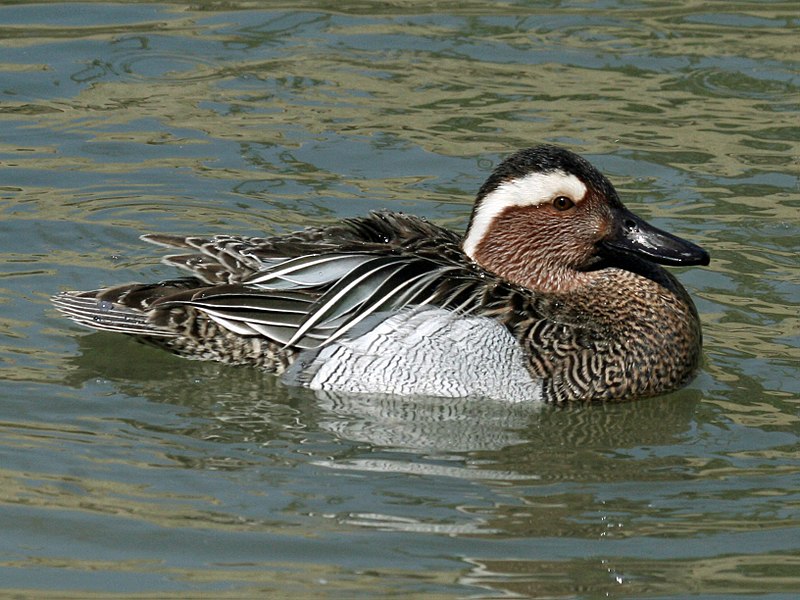
The Garganey is a small dabbling duck that breeds in much of Europe and across the Palearctic. During winter, it migrates to southern Africa, India (Santragachi), Bangladesh (in Sylhet district) and Australasia where large flocks can be seen.
It has an unmistakable appearance with its brownish head and grey body covered by white patches on both sides along with blue speculum feathers at the back of wings.
Its diet mostly consists of aquatic vegetation such as grasses, sedges or pondweeds which are usually collected from shallow waters like marshes or ponds while swimming.
The species is vulnerable due to loss of wetland habitats caused by drainage for agriculture purposes or urban development making them increasingly rarer throughout their range.Scientific classification:
| Kingdom | Animalia |
| Phylum | Chordata |
| Class | Aves |
| Order | Anseriformes |
| Family | Anatidae |
| Genus | Spatula |
| Species | S. querquedula |
Also Featured In: Kuwait Birds, Birds that Migrate to Sri Lankan
39. Black-Winged Pratincole
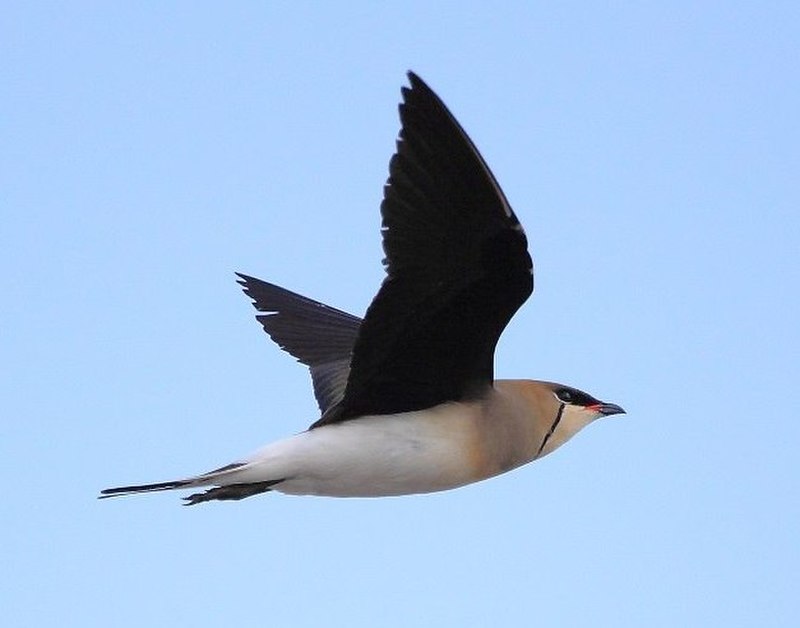
The Black-winged Pratincole is a wader belonging to the Glareolidae family. It measures about 24 – 28 cm in length and has short legs, long pointed wings, as well as a forked tail.
This species was named after Finnish zoologist Alexander von Nordmann and nests in gravel habitats.
Its diet consists of insects which it catches on the wing while flying low over fields or water surfaces with rapid beating wings.
During breeding season it exhibits an extraordinary courtship flight accompanied by singing noises usually above its nesting grounds where they often breed in colonies together with other pratincoles or lapwings.
The black-winged pratincole also migrates great distances during winter months spending time primarily around Africa’s Mediterranean coastlines before heading back northwards when Spring arrives again.Scientific classification:
| Kingdom | Animalia |
| Phylum | Chordata |
| Class | Aves |
| Order | Charadriiformes |
| Family | Glareolidae |
| Genus | Glareola |
| Species | G. nordmanni |
Also Featured In: Qatar birds,
40. Baillon’s Crake
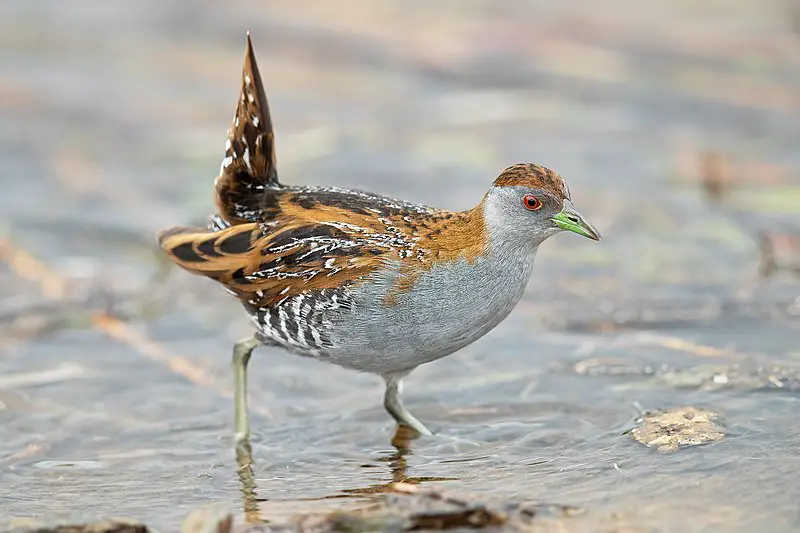
Baillon’s crake is a species of small waterbird belonging to the Rallidae family.
It breeds in Europe, mainly eastwards but also stretching across Palearctic regions, and has experienced an upsurge in North-Western breeding areas after its numbers depleted due to drainage during the mid 19th century.
Its preferred habitat consists of sedge beds which provide it with food as well as shelter from predators.
With brown upperparts and white underparts that are marked by dark barring on wings and flanks, Baillon’s Crakes have yellowish eyes along with pale green legs; they measure around 16cm long when fully grown.
Their diet includes insects such as beetles and grasshoppers alongside aquatic invertebrates like snails or ants found near their nesting grounds.Scientific classification:
| Kingdom | Animalia |
| Phylum | Chordata |
| Class | Aves |
| Order | Gruiformes |
| Family | Rallidae |
| Genus | Zapornia |
| Species | Z. pusilla |
Also Featured In: Luxembourg birds,
41. Grey Wagtail
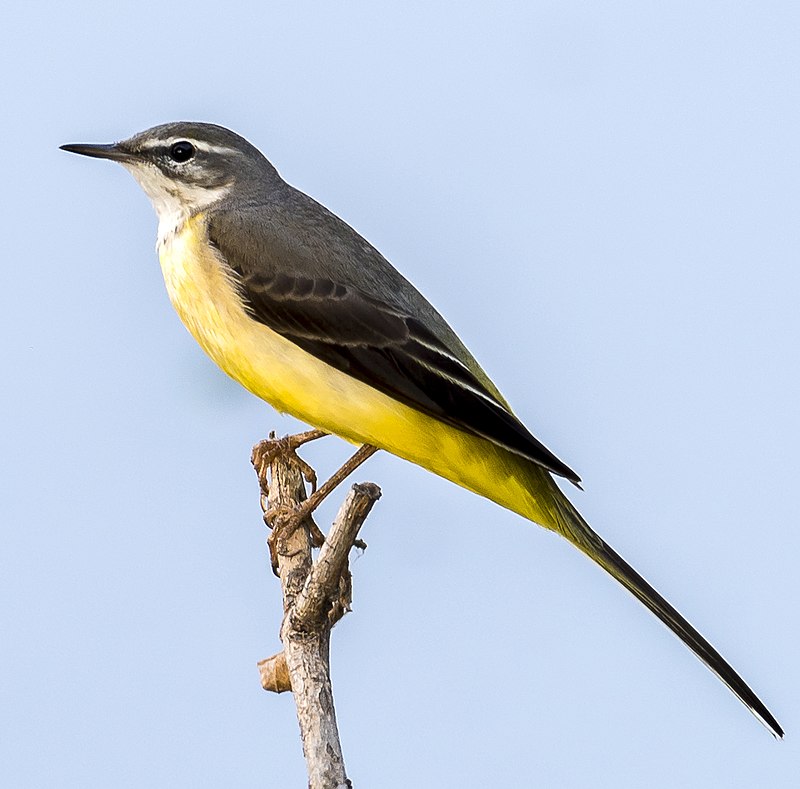
The Grey Wagtail is a beautiful bird species, belonging to the Motacillidae family. It measures 18-19 cm in length and has distinctive black throat markings for breeding males.
Their yellow colouring on their underside extends from the throat to the vent area only. This species can be found across Europe and Siberia during its breeding season before migrating further south towards tropical areas of Asia or Africa.
Its diet consists mainly of insects which it catches with quick movements as it usually hops or flutters around watercourses such as streams, rivers or lakesides – although they are also seen near roads too.
The grey wagtail makes an attractive addition to any garden so why not give them a chance by providing food sources like peanuts and sunflower hearts?Scientific classification:
| Kingdom | Animalia |
| Phylum | Chordata |
| Class | Aves |
| Order | Passeriformes |
| Family | Motacillidae |
| Genus | Motacilla |
| Species | M. cinerea |
Also Featured In: Czech Republic Birds, Moorland Birds You Need to Know
42. Common Redstart
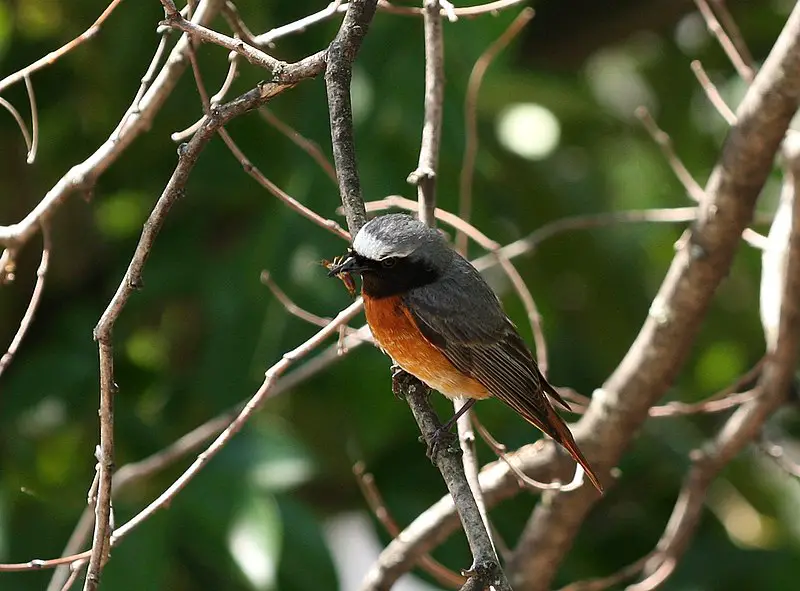
The Common Redstart is a small passerine bird found in the Phoenicurus genus. It was once classified as part of the thrush family but it has since been identified as an Old World flycatcher.
The species was first formally described by Swedish naturalist Carl Linnaeus in 1758 and is known for its predominantly reddish-orange plumage, hence its name red start.
This beautiful little bird inhabits open woodlands across Europe, Asia and northern Africa where they feed on insects such as flies, moths and beetles which they catch while flying or hovering over vegetation with their wings spread out like fans.
They also enjoy consuming fruits when available during autumn months – making them a welcome visitor to any garden.
These birds are not only aesthetically pleasing but also beneficial to local ecosystems due to their diet of insect pests that can be harmful to plants.Scientific classification:
| Kingdom | Animalia |
| Phylum | Chordata |
| Class | Aves |
| Order | Passeriformes |
| Family | Muscicapidae |
| Genus | Phoenicurus |
| Species | P. phoenicurus |
Also Featured In: birds of orange, Common Slovakian Birds
43. European Nightjar
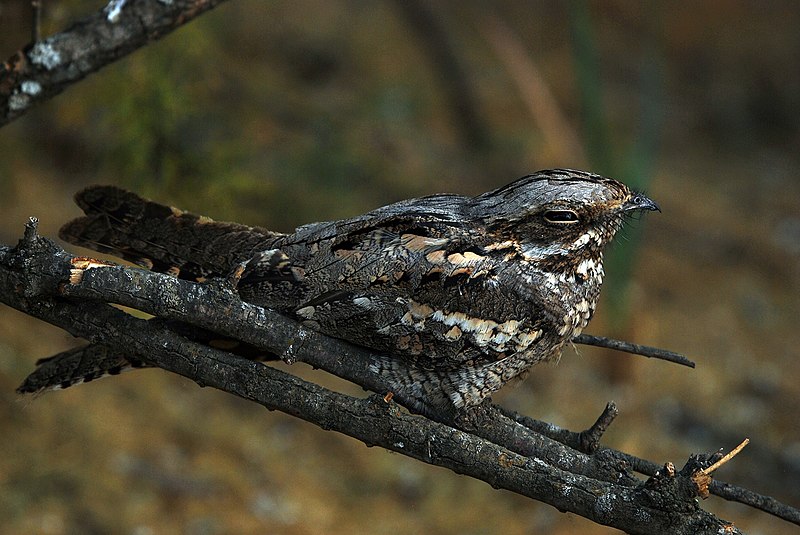
The European nightjar is a nocturnal bird that can be found in Europe, the Palearctic region, Mongolia, and Northwestern China.
It belongs to the nightjar family and is known by several names, including the common goatsucker and Eurasian nightjar.
There are six subspecies of this bird. The nightjar is crepuscular, meaning it is most active during dawn and dusk.
Its Latin generic name comes from an old myth that the bird suckled from goats, causing them to stop giving milk.
The European nightjar is well-adapted to its nocturnal lifestyle with large eyes and wide gape that help it catch flying insects in the dark.
Its plumage is cryptic, blending in with its surroundings, making it difficult to spot. The bird usually nests on the ground, and the male performs aerial displays during breeding season.Scientific classification:
| Kingdom | Animalia |
| Phylum | Chordata |
| Class | Aves |
| Clade | Strisores |
| Order | Caprimulgiformes |
| Family | Caprimulgidae |
| Genus | Caprimulgus |
| Species | C. europaeus |
Also Featured In: Turkey Birds You Should Know, Italian Birds You Should Know
44. Little Grebe
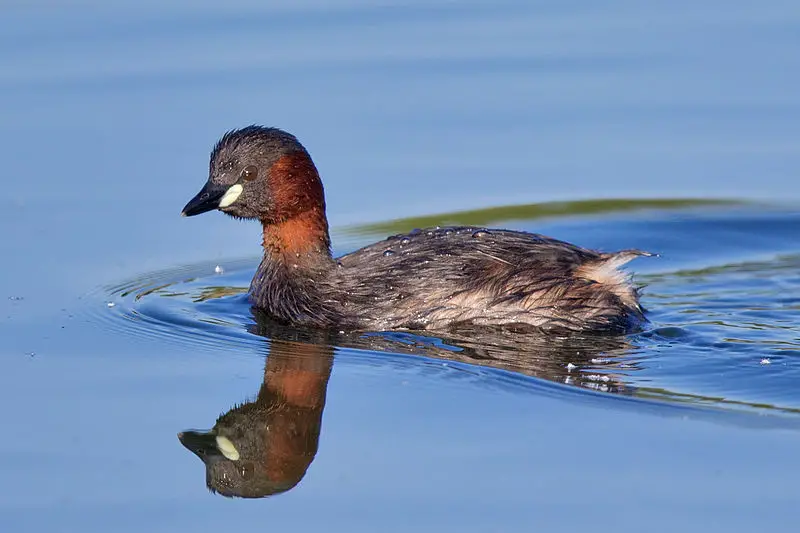
The little grebe, also known as dabchick, belongs to the grebe family and is a small water bird. It gets its genus name from the Ancient Greek words for ‘fast’ and ‘to sink under’.
The specific name ruficollis means ‘red-necked’ in Latin. With a length of 23 to 29 centimetres, it is the smallest member of the grebe family.Scientific classification:
| Kingdom | Animalia |
| Phylum | Chordata |
| Class | Aves |
| Order | Podicipediformes |
| Family | Podicipedidae |
| Genus | Tachybaptus |
| Species | T. ruficollis |
Also Featured In: Common Uzbekistan Birds, Native Birds of Kazakhstan
45. Greylag Goose
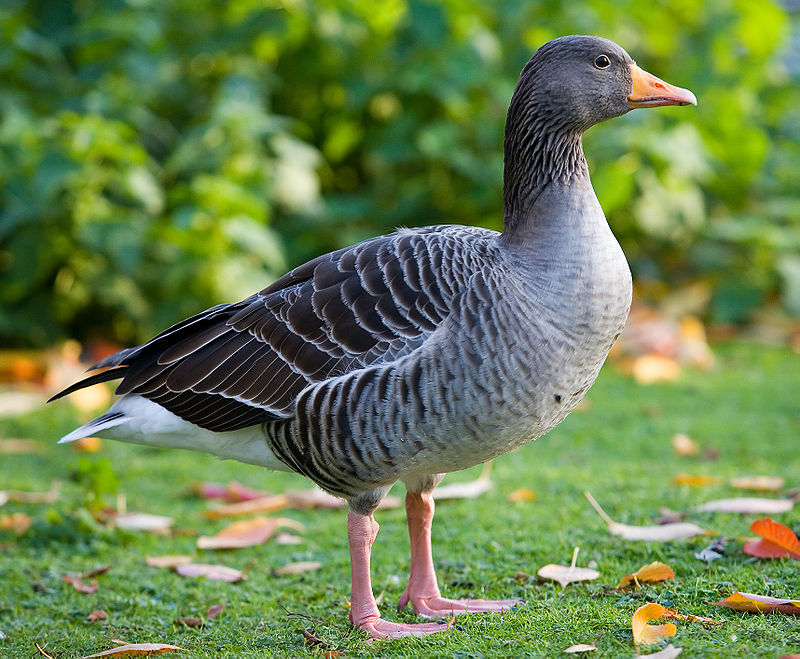
The Greylag goose, also known as the Graylag goose, is a large waterfowl bird belonging to the Anatidae family.
This bird species is the typical species of the genus Anser and is easily identified by its mottled and barred grey and white plumage, orange beak, and pink legs.
It is a big bird, measuring between 74-91 centimeters in length and weighs an average of 3.3 kilograms.
The Greylag goose is widely distributed and found in various habitats throughout its range. Despite being large birds, they are known for their graceful and elegant flight style.
These birds also mate for life and the pairs bond during the breeding season. Due to their robust nature, Greylag geese are highly protected, and their numbers are steadily increasing.Scientific classification:
| Kingdom | Animalia |
| Phylum | Chordata |
| Class | Aves |
| Order | Anseriformes |
| Family | Anatidae |
| Genus | Anser |
| Species | A. anser |
Also Featured In: Ukrainian Birds You Should Know, Most Common Scotland Birds
46. Greater Spotted Eagle
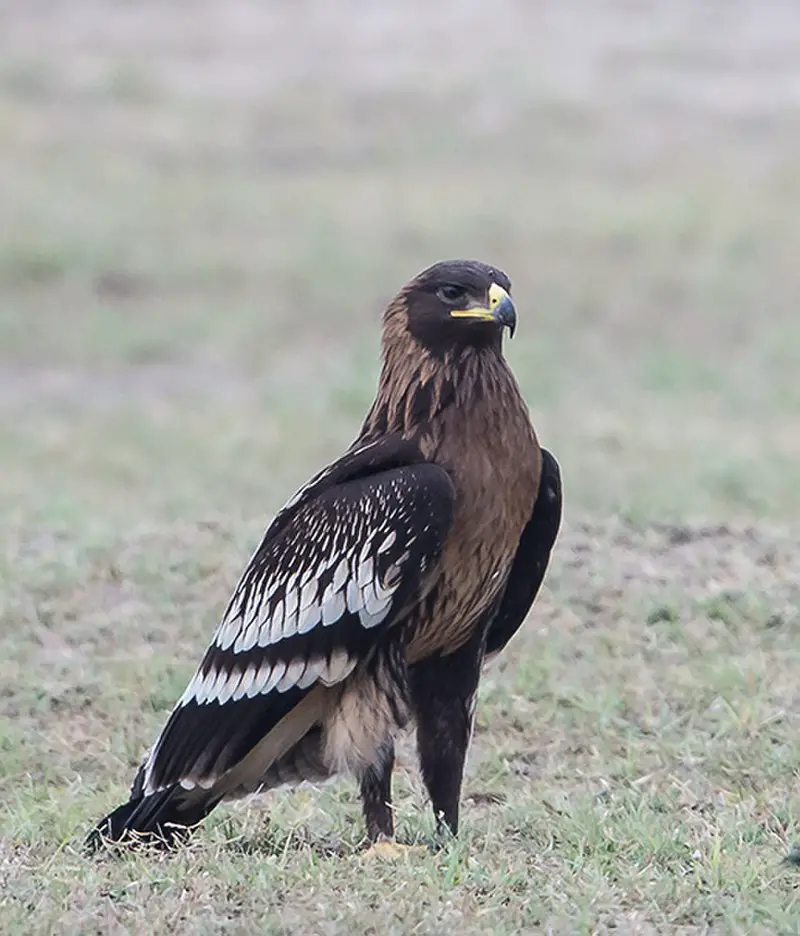
The greater spotted eagle is a large bird of prey that belongs to the Accipitridae family. It is also known as the spotted eagle and has feathered legs that indicate its membership in the subfamily Aquilinae, also called the “booted eagles.”
Although previously considered a member of the Aquila genus, it has been recently reclassified in the Clanga genus, along with other eagle species.
The greater spotted eagle is a magnificent bird with a wingspan of up to 2 meters and is known for its hunting skills.
Due to habitat loss and degradation, its population has been declining, leading it to be classified as a vulnerable species on the IUCN Red List.
Conservation efforts are needed to ensure the survival and protection of this majestic bird.Scientific classification:
| Kingdom | Animalia |
| Phylum | Chordata |
| Class | Aves |
| Order | Accipitriformes |
| Family | Accipitridae |
| Genus | Clanga |
| Species | C. clanga |
Also Featured In: Syrian Birds You Need to Know, Lebanon Birds Live in Semi-Desert Areas
47. Waxwing Birds
Waxwings are charming and distinctive birds found in North America, Europe, and Asia. They are known for their striking plumage, with smooth, silky feathers, and their unique ability to eat fruit without getting drunk.
Waxwings are social birds that travel together in large flocks and communicate with soft high-pitched trills.
These birds are small, measuring up to 7 inches in length and weigh around 1 oz. Their diet mainly consists of insects, but during the winter, they switch to a fruit-based diet.
Waxwings are monogamous birds that form long-term pair bonds, in which they share parental responsibilities.
These birds are considered a bioindicator for the health of ecosystems because they are sensitive to environmental changes.
Overall, Waxwings are delightful birds that add color and beauty to the natural world.
48. Savi’s Warbler
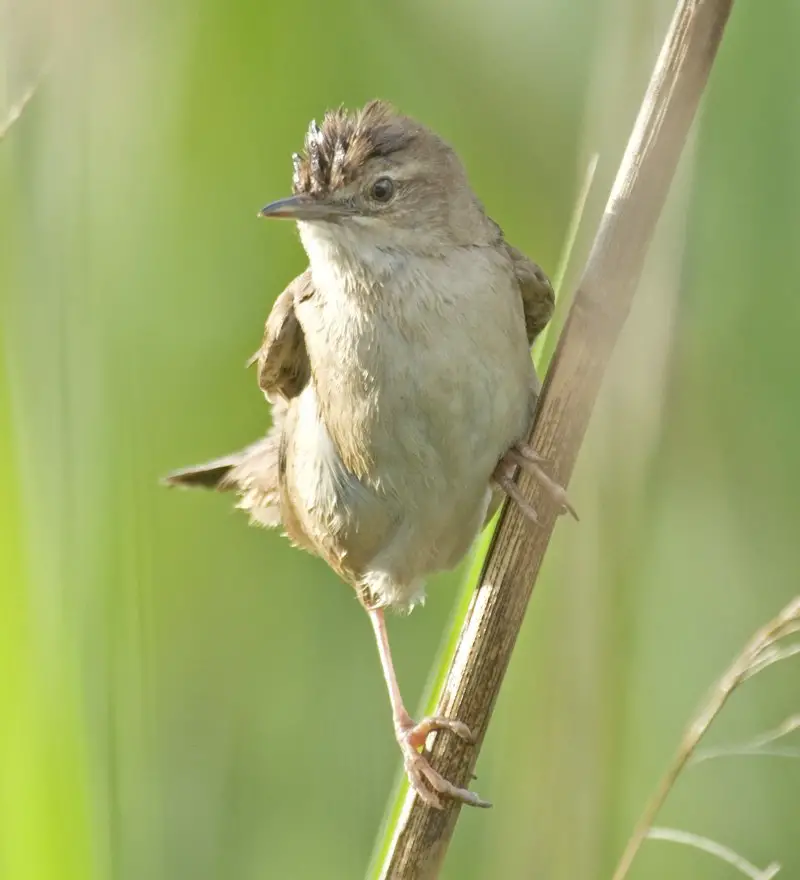
Savi’s warbler is a small, migratory bird found in Europe and the western Palearctic. This Old World warbler breeds in reed beds with some bushes and lays 3-6 eggs in a nest made of reeds.
The adult bird has a grey-brown back with no streaks and a whitish underside. It spends its winters in northern and sub-Saharan Africa.
This species belongs to the grass warbler genus Locustella and is known for its distinctive, high-pitched song.
Despite the bird’s brownish appearance, its song has been described as “metallic” or “bell-like.” Savi’s warbler is a unique and important species in its ecosystem, contributing to the biodiversity of its various habitats.Scientific classification:
| Kingdom | Animalia |
| Phylum | Chordata |
| Class | Aves |
| Order | Passeriformes |
| Family | Locustellidae |
| Genus | Locustella |
| Species | L. luscinioides |
49. Red-Necked Phalarope
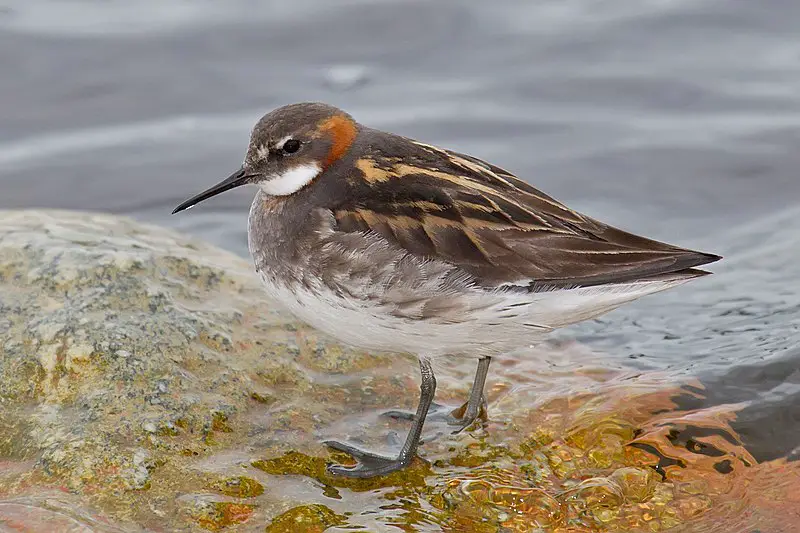
The Red-necked phalarope is a small wading bird that breeds in the Arctic regions of North America and Eurasia. It is also known as the Northern phalarope and Hyperborean phalarope.
Unlike other wading birds, it spends its winters at sea on tropical oceans, making it a migratory bird.
In 1743, the English naturalist George Edwards described this bird and included an illustration.
The Red-necked phalarope is known for its unique feeding behavior, where it spins in circular motions to create a vortex in the water, which brings food to the surface. This bird has a red neck, gray back, white belly, and a straight, thin beak.
During breeding season, the female takes on more vibrant colors, while the male incubates the eggs and cares for the chicks.
The Red-necked phalarope is a fascinating bird with unique characteristics that make it stand out among other wading birds.Scientific classification:
| Kingdom | Animalia |
| Phylum | Chordata |
| Class | Aves |
| Order | Charadriiformes |
| Family | Scolopacidae |
| Genus | Phalaropus |
| Species | P. lobatus |
Also Featured In: Shetland Islands Birds You Should Know, Birds that Live in Greenland